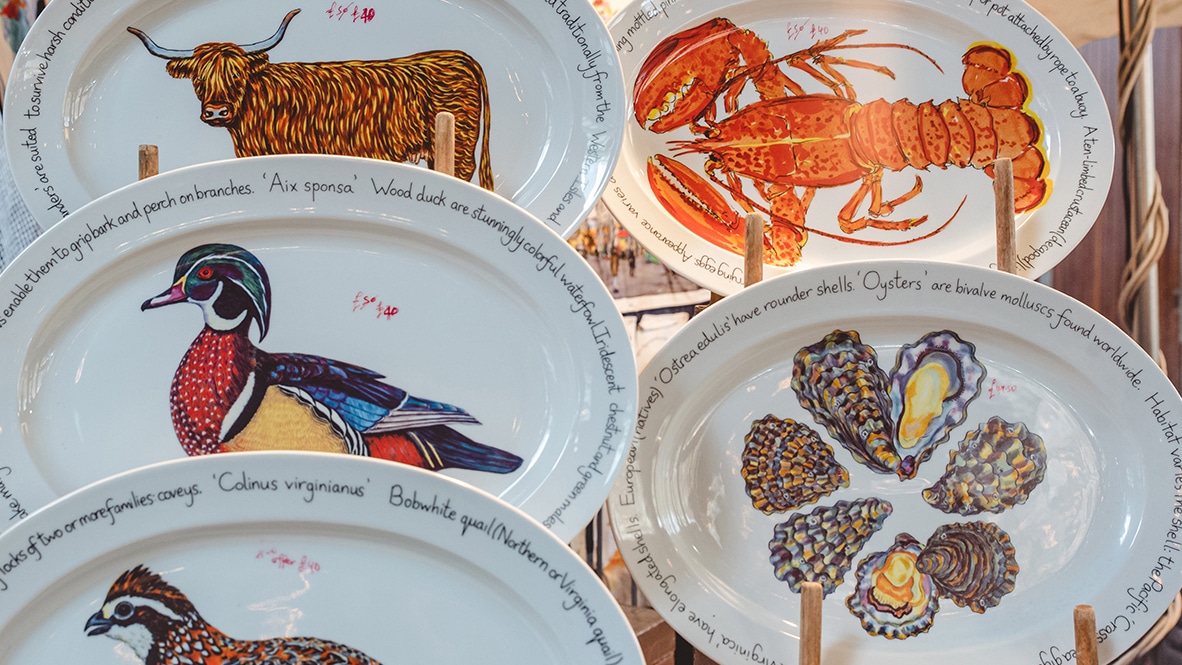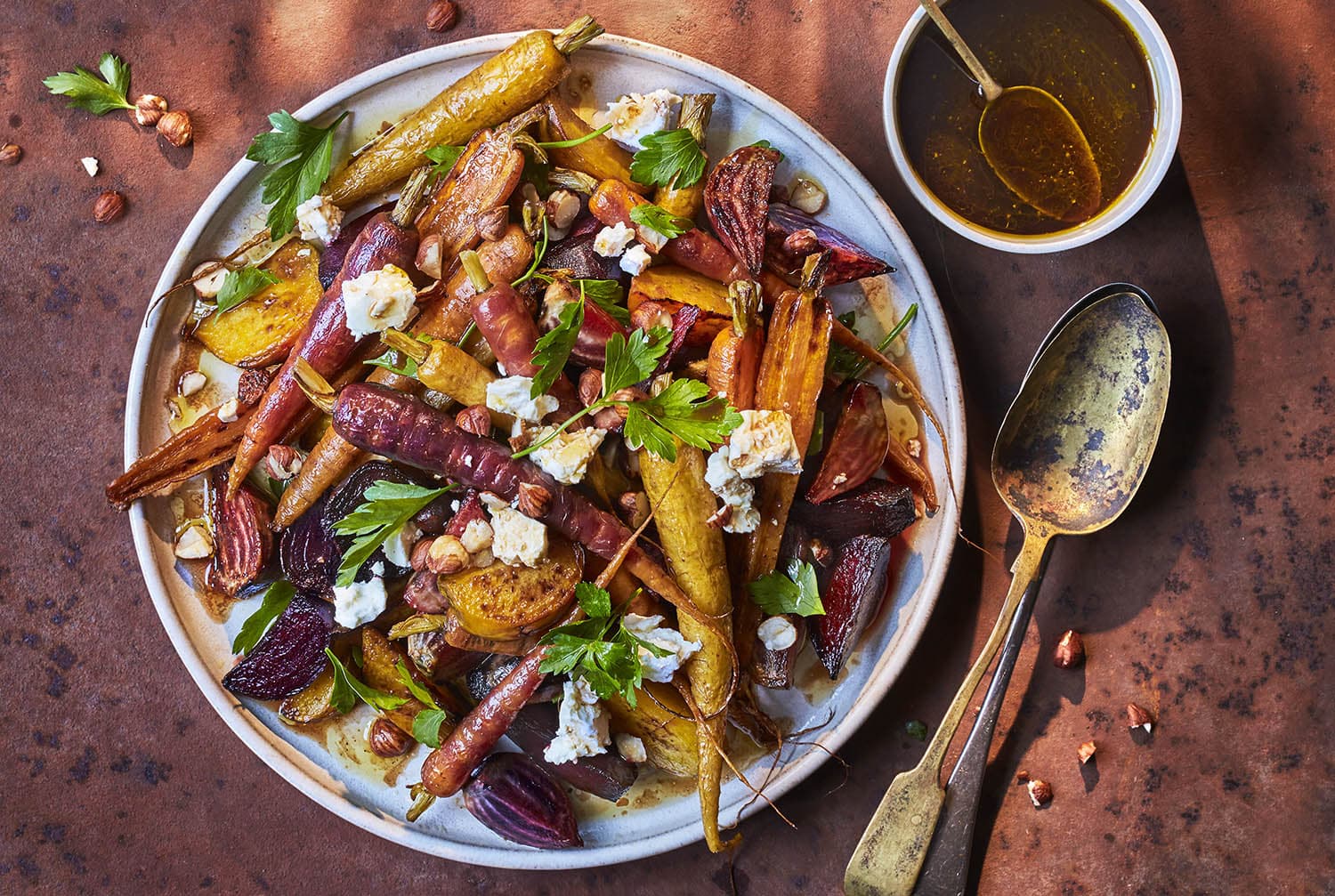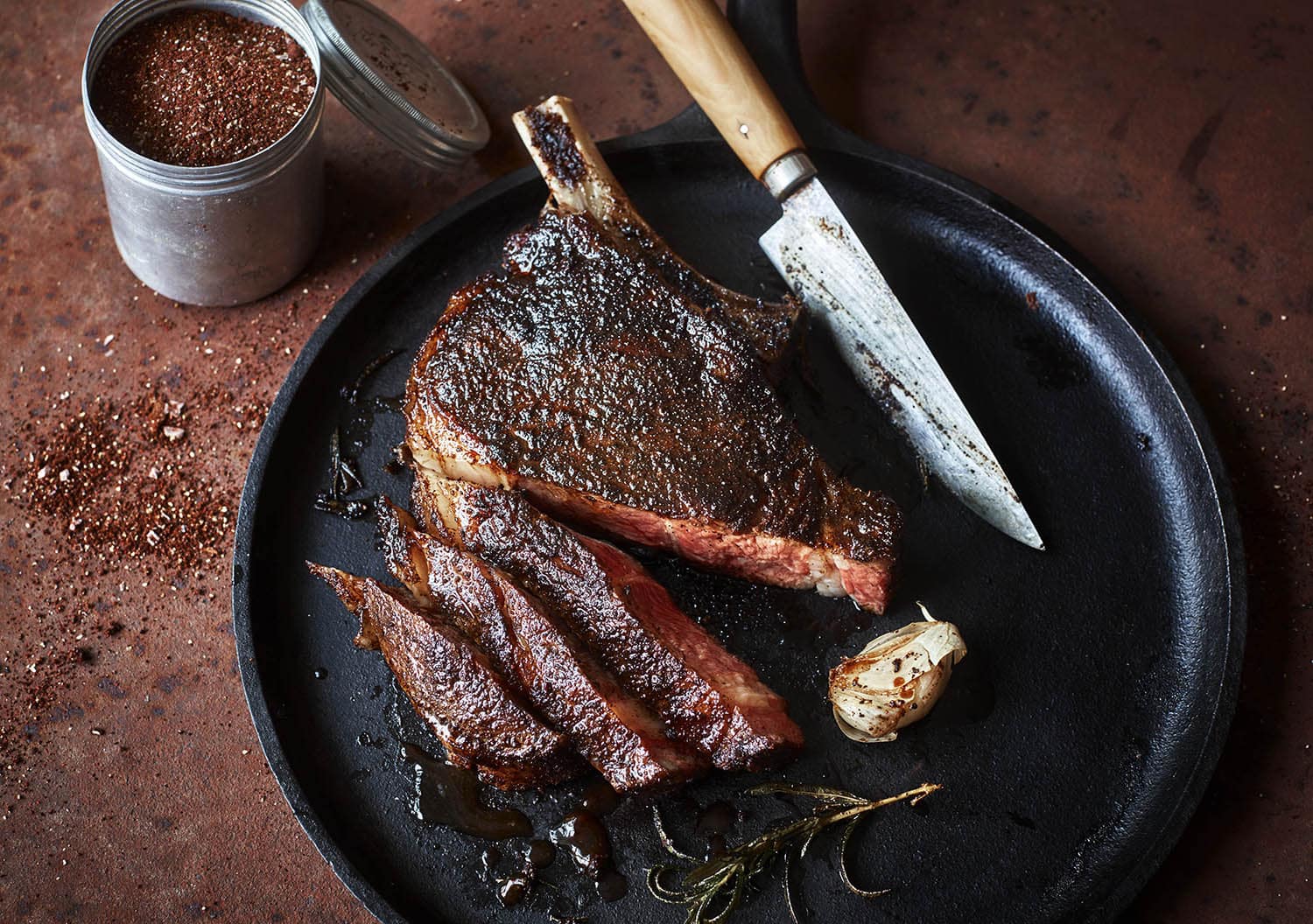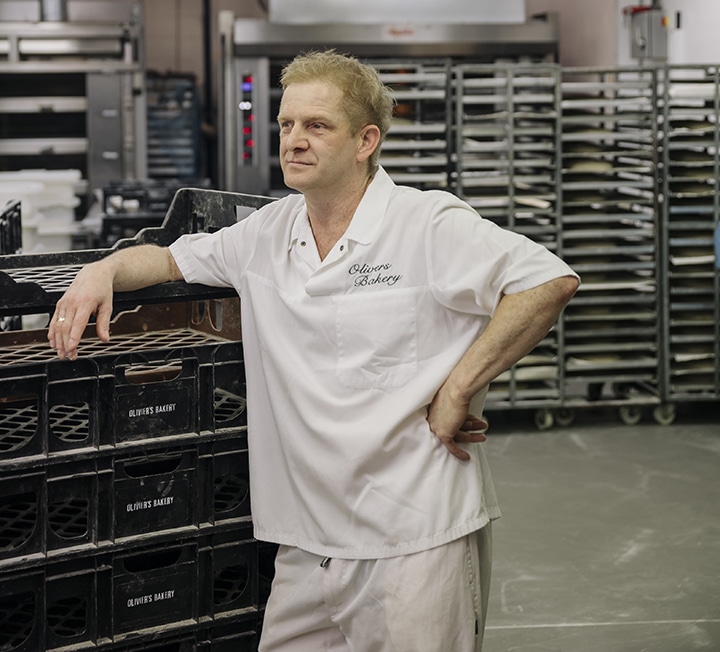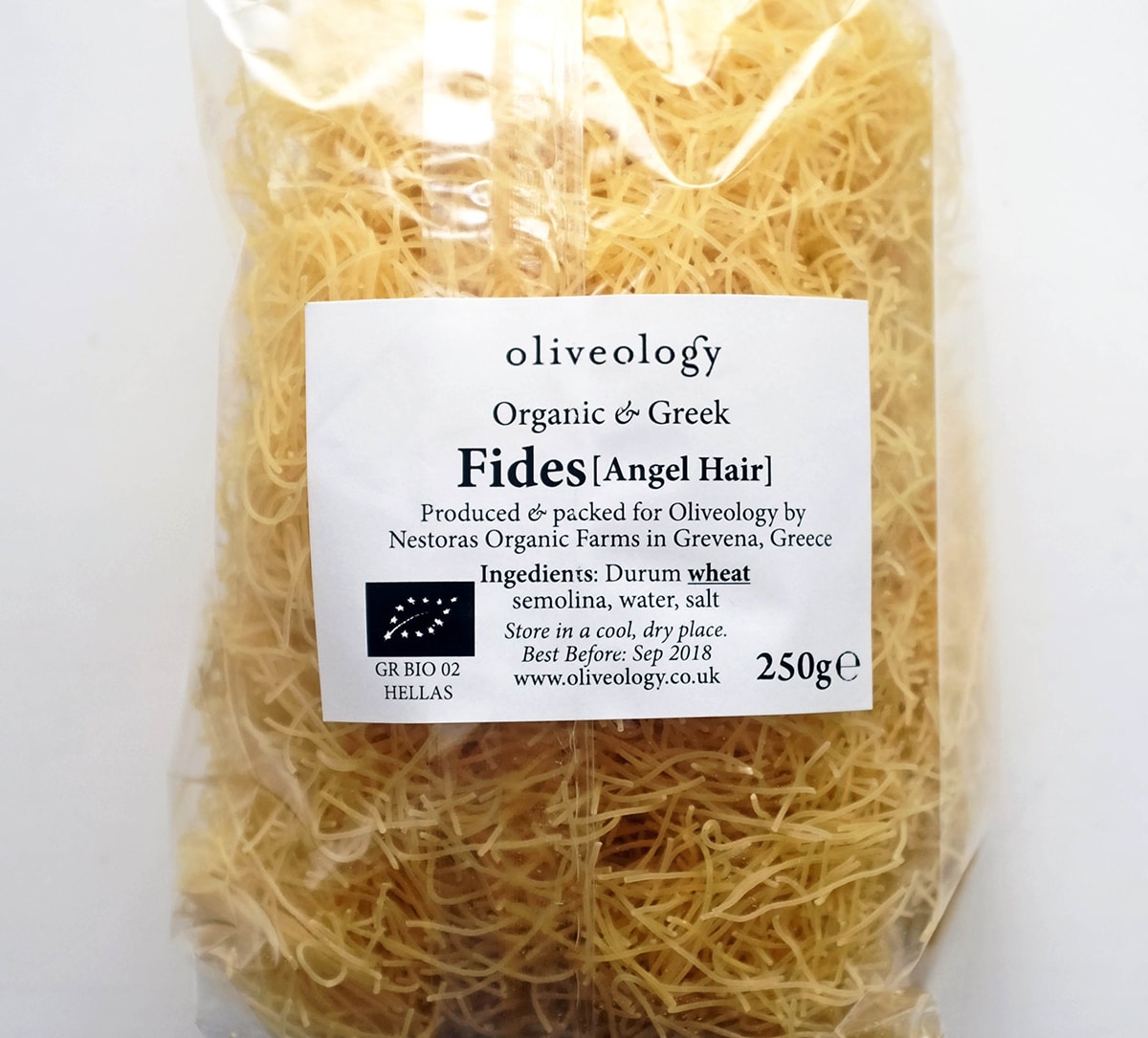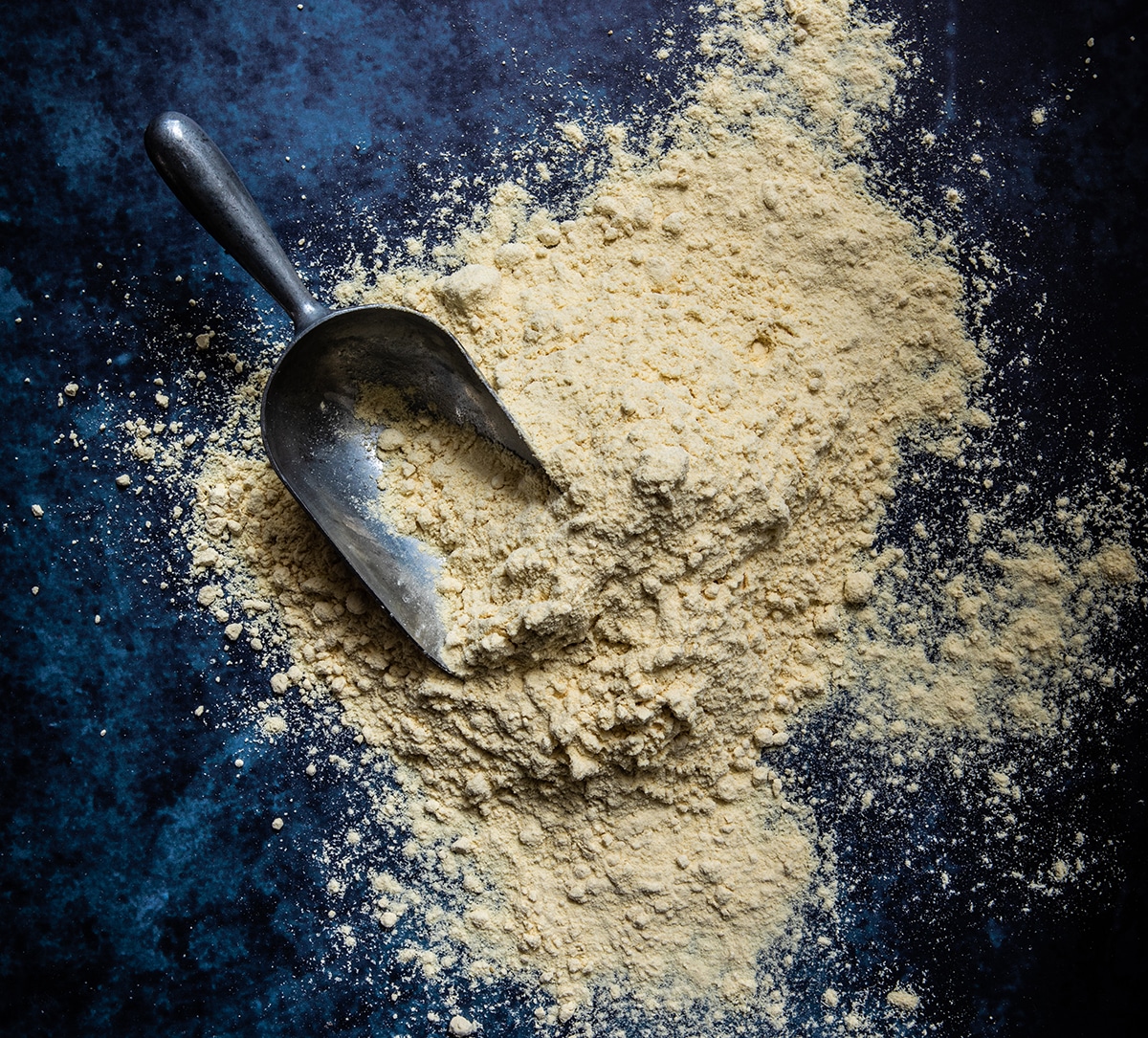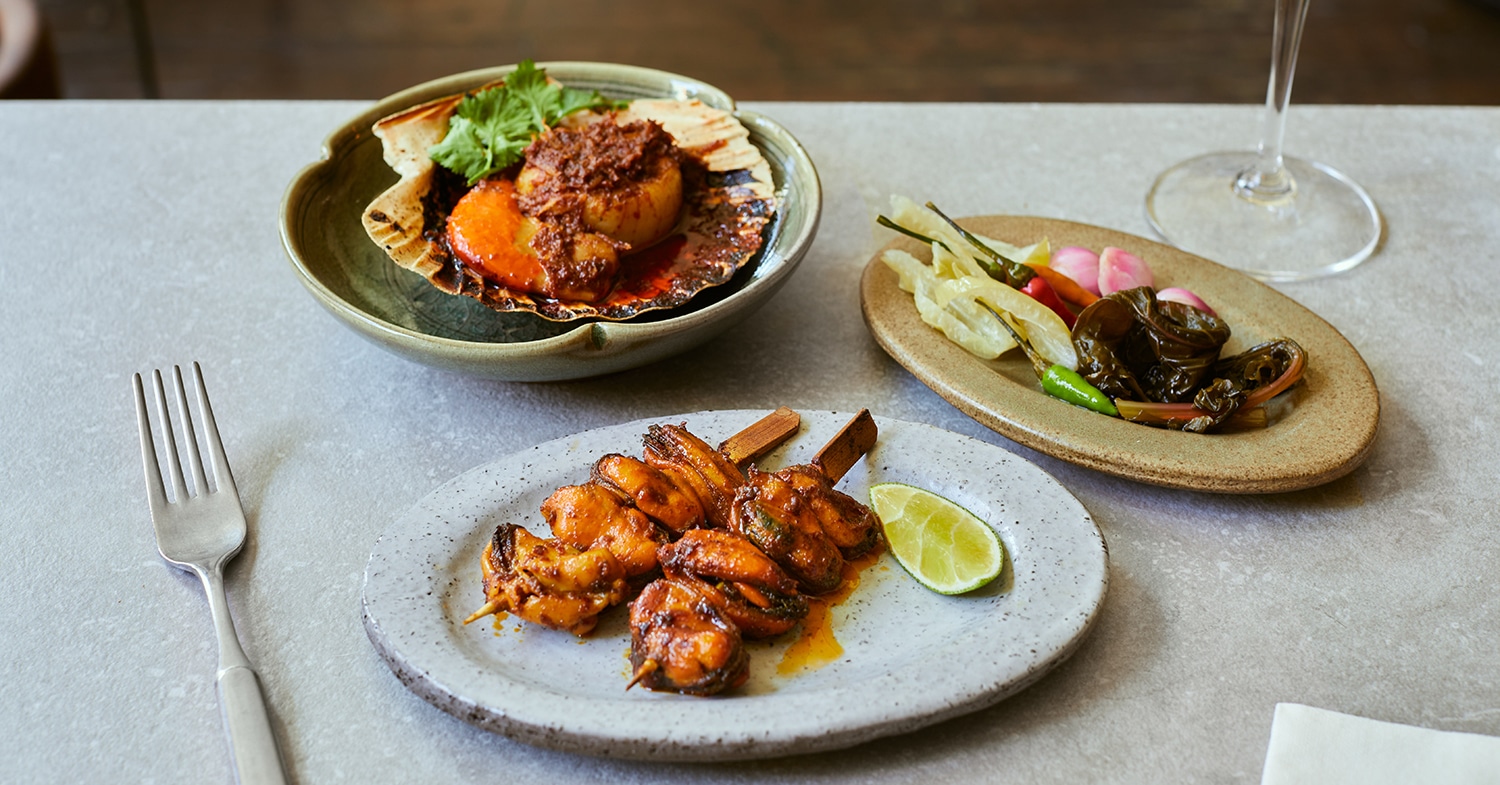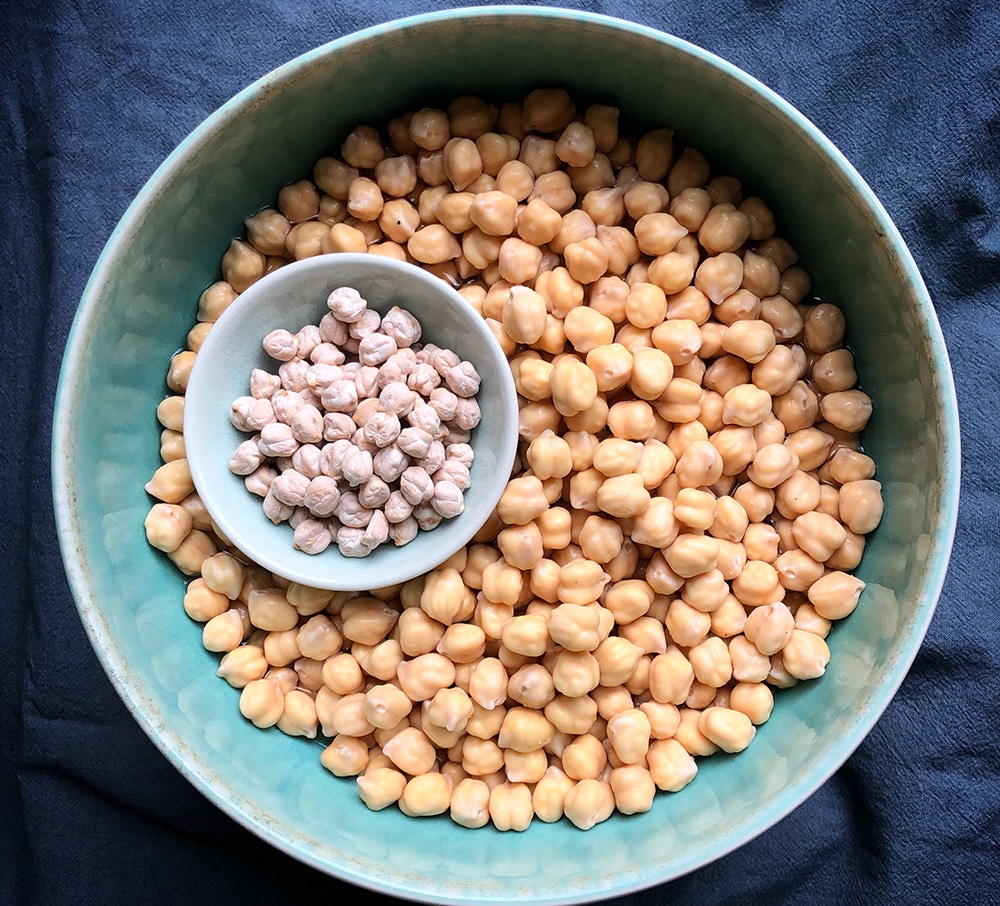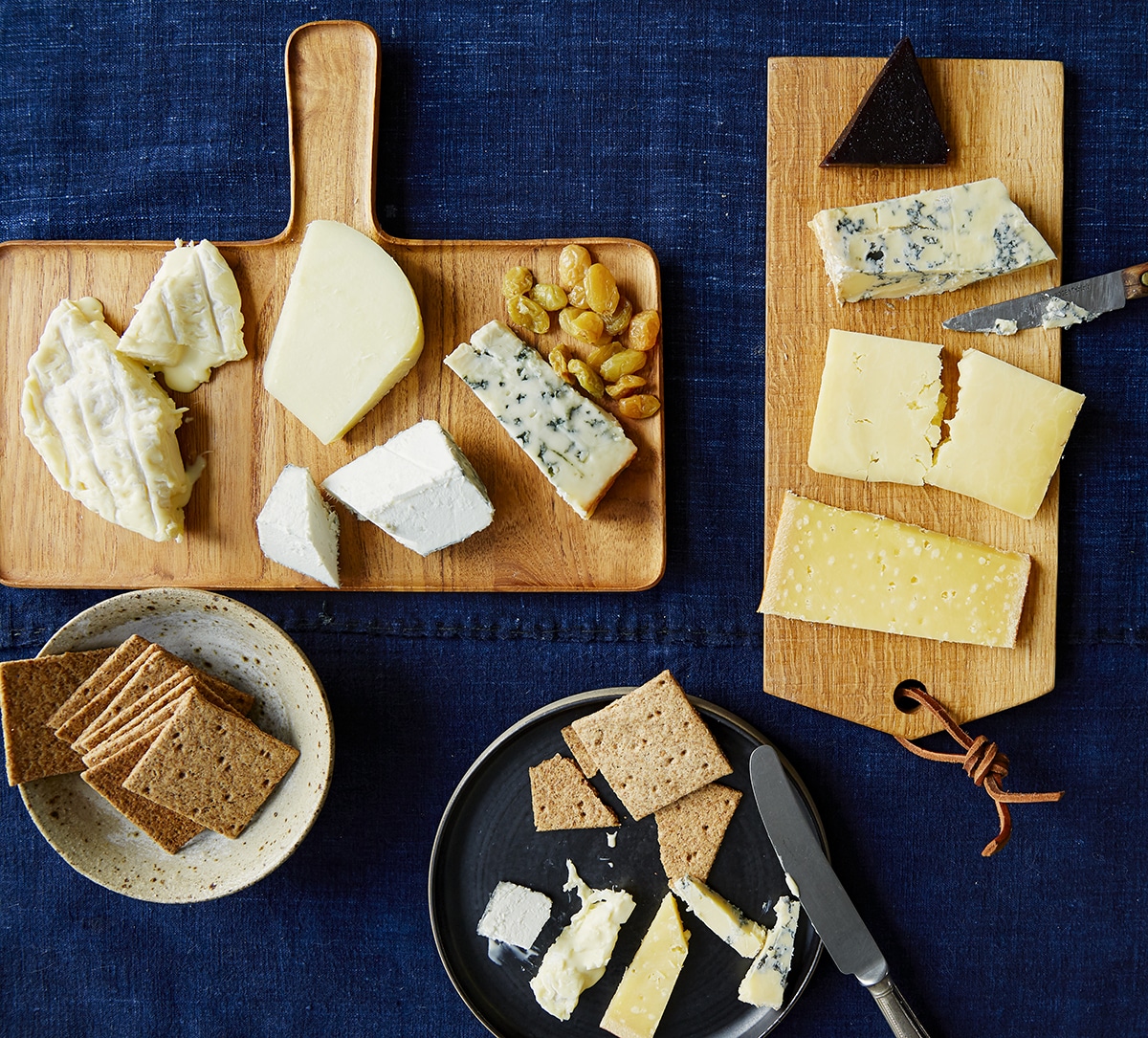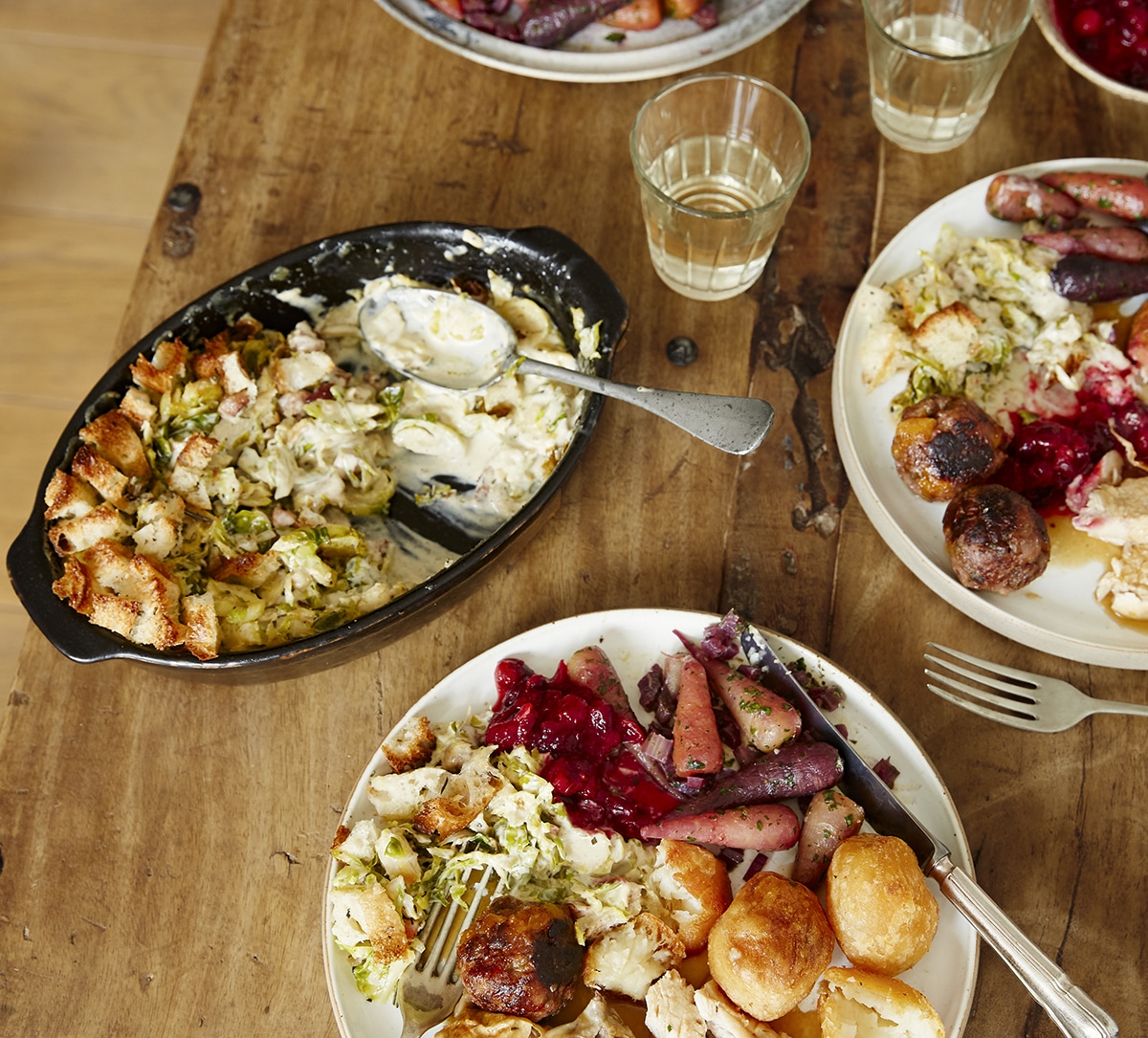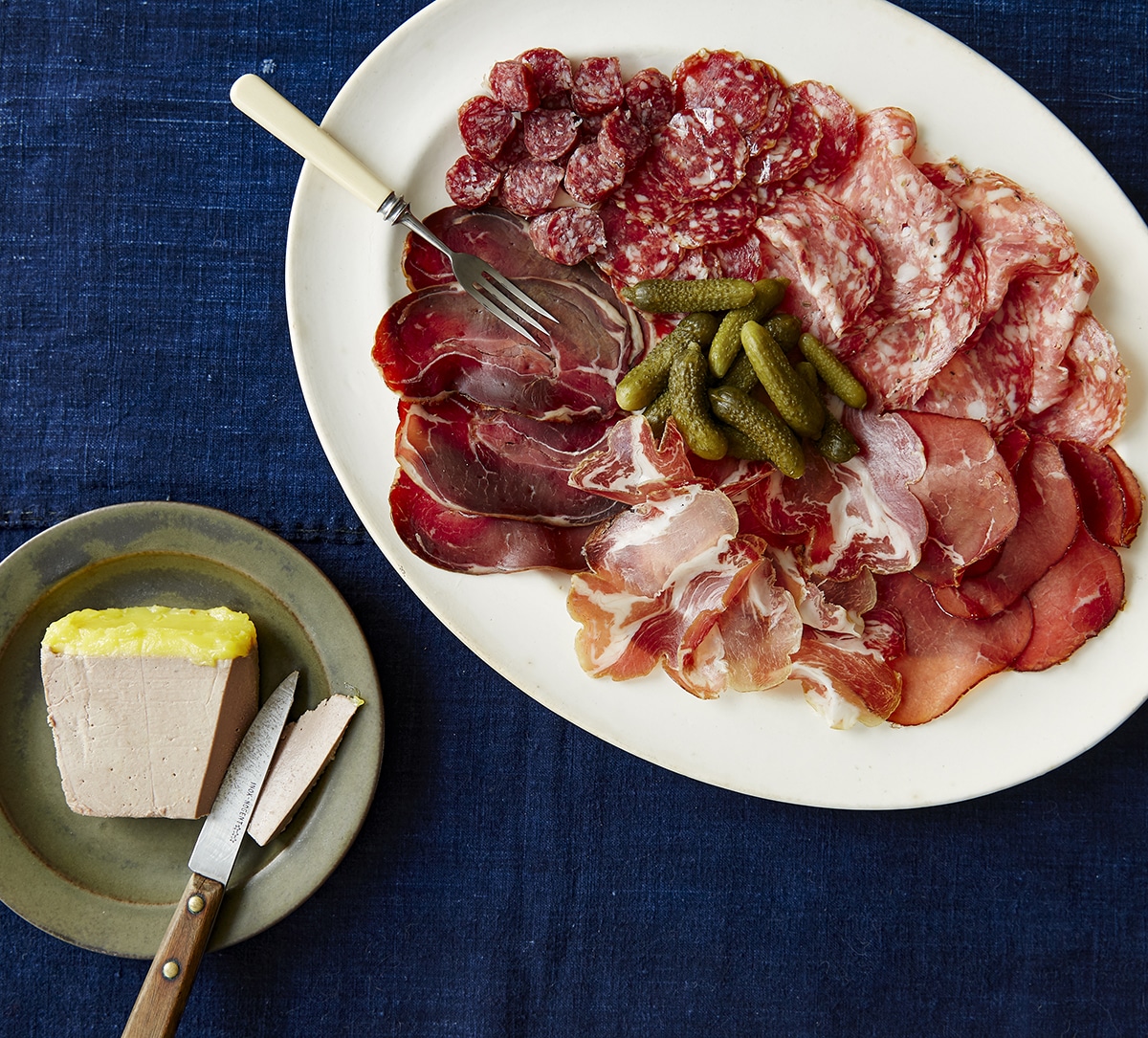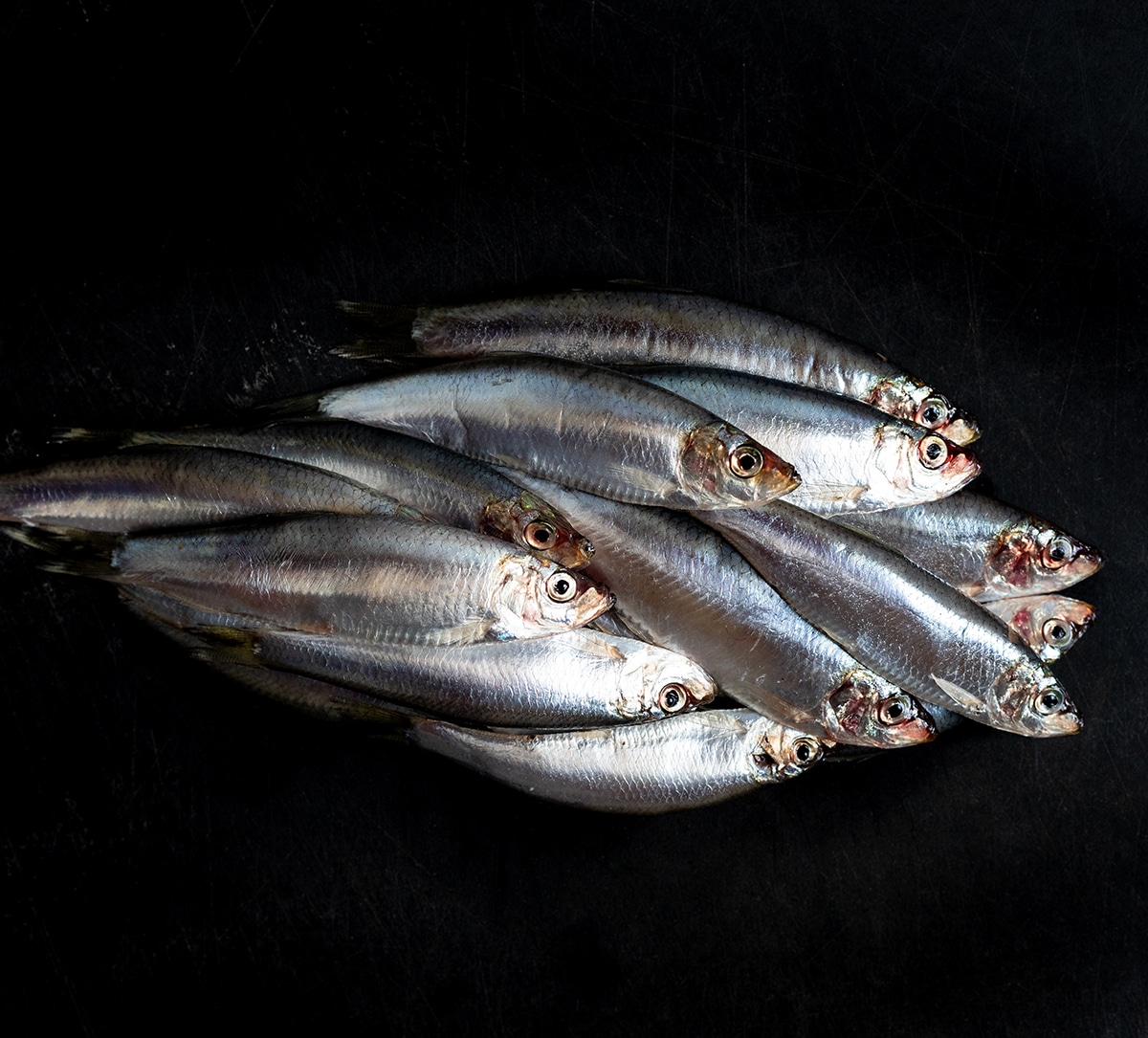Q&A: Flip Dunning
For International Women’s Day, the founder of Pâté Moi discusses her mushroom pâté, the joys of being a market trader, and the secret to her cult following
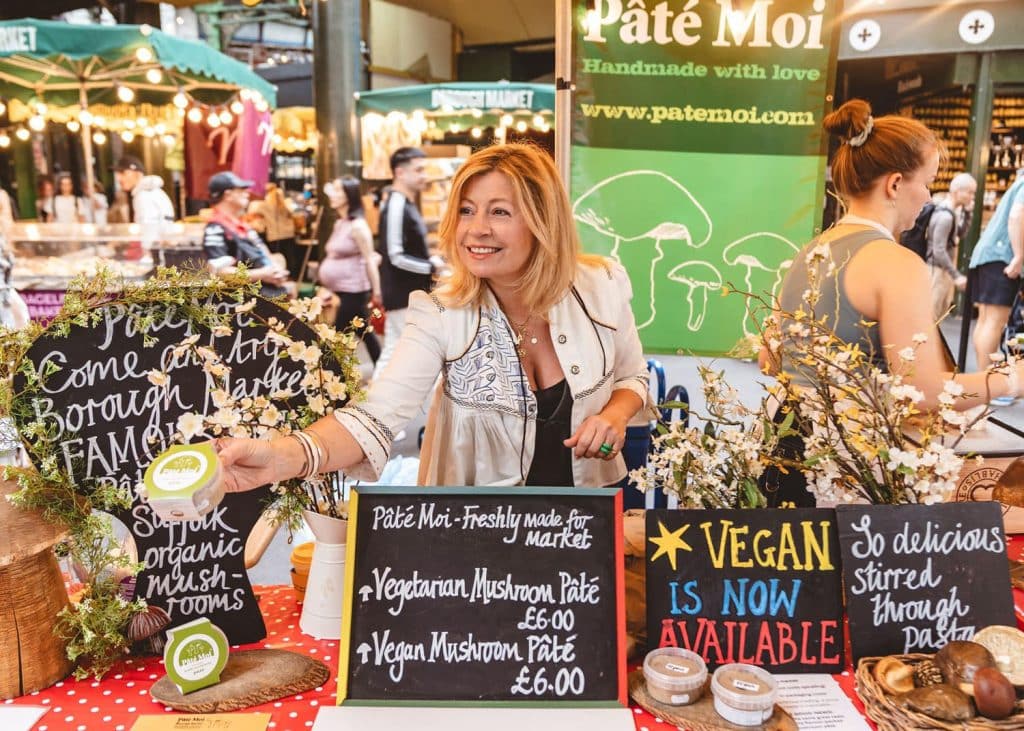

“IT’S STILL MADE BY HAND EVERY SINGLE WEEK, LESS THAN A MILE AWAY. THE ONLY THING THAT’S CHANGED IS THE VOLUME”
Interview: Mark Riddaway
Flip Dunning has a vivid memory of the moment her life changed. “I’d been at a wedding and got in really late, about two or three in the morning. There was a Borough Market envelope on the mat. and I thought, after this everything could be different. I could barely open it, my hand was shaking so much. I pulled the letter out a bit, and I could see the word ‘Congratulations’. I was like: ‘Oh my gosh, this is it, I’ve done it.’”
It was almost 20 years ago, after a comprehensive, nerve-shredding application process, that Flip made the leap from food-loving advertising executive to founder and sole employee of Pâté Moi, a mushroom pâté business and a trader at London’s most famous produce market. She’s been here ever since, selling her magical handmade pâté and, despite its stellar popularity, resisting any temptation to turn her small, hands-on business into something more corporate.
Where did your love of food come from?
In my family we were born cooking, all of us. My dad was a huge cook, my mum was a huge cook, we ate brilliantly as kids, we tried absolutely everything. We had our own hens, grew our own veg, baked our own bread. I was already really into food by about the age of five. I was a massive anchovy eater. For my eighth birthday I asked for my breakfast, lunch and dinner to be anchovies! By the age of 10 or 11 I was making my own anchoïade – you mash some anchovies in a pestle and mortar, with garlic, a drop of brandy, black pepper, thyme, a little lemon juice, and some butter. Pound it all together and spread it on some really good baguette. That was my childhood snack!
You grew up in Cheshire. What brought you to London?
I came to do an English literature degree at UCL. While I was at uni, I did lots and lots of cooking – it was too expensive to eat out, so we’d host parties in our flat. I’d bake the bread, I’d make the soup, cook a main course. That’s when I started making the mushroom pâté. It was my brother who originally invented the recipe when he was eight. Everyone loved it. I remember one of my really good friends saying to me: “Oh my God, you should sell this!” That lodged in my brain for years.
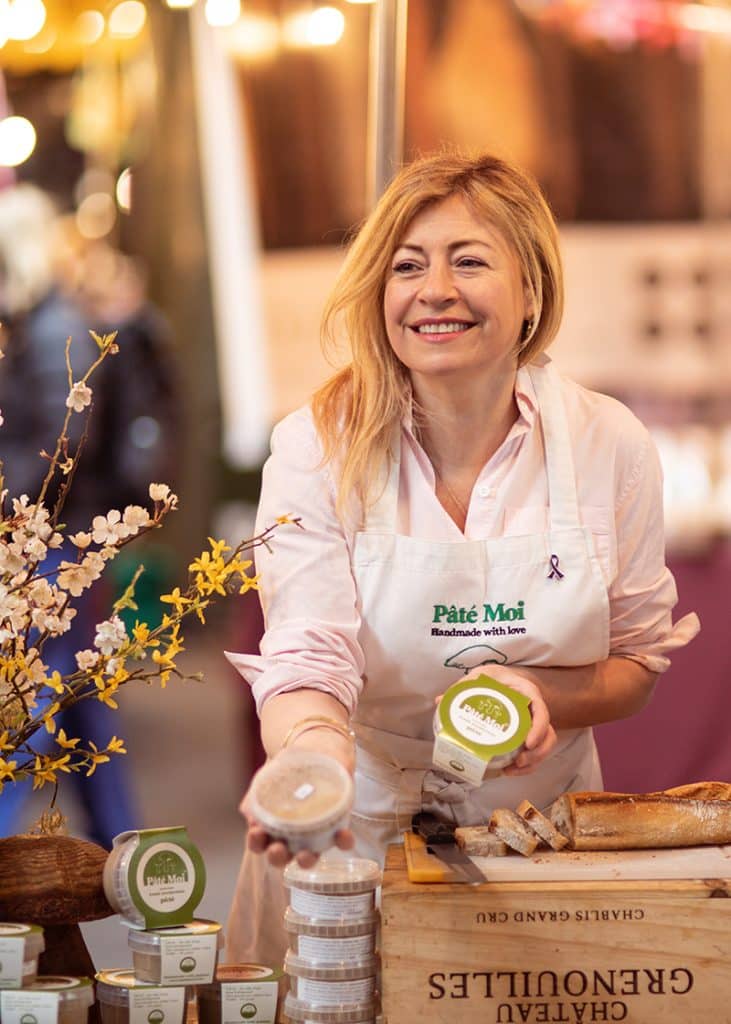
Your very first step into the food world was your application for a stall at Borough Market. What led you to apply?
I worked in advertising for about nine years, still cooking all the time, and I used to come to Borough Market a lot – every Saturday. At the end of the day, I’d see everyone packing up their stalls, folding up their tablecloths, and I remember thinking how much I would love the satisfaction of making something of my own thing, selling it, and then finishing for the day. My old job took me all over the world, it was very intensive, but you never really had that moment of completion, of satisfaction. I decided I wanted to make my mushroom pâté and I wanted to sell it here. It was a complete leap into the unknown!
What do you remember of your first day of trading?
After I was accepted, my dad died, and it was absolutely terrible. I wrote to Borough by hand. I told them how much it had meant to me to be offered this chance, and how dad had encouraged me with food all my life. Would they let me delay my start? They wrote me the most amazing letter back offering their sympathy and saying that they were going to keep my place open for a year. I started on 8th September 2006. It was a blue-sky day, really cold. I set out my stall and waited. My first customer was an American man. I’ve never forgotten him. He picked up a sample and tasted it. I just watched. I couldn’t breathe. “Oh my God,” he said. “That’s one of the nicest things I’ve ever tasted.” He bought my first pot. I phoned my mum straight away to tell her! From that moment I never looked back. I’d sold out by 1pm and had to work all through the night to make enough for the next day!
Compared with that first pot, how different is the pâté you’re selling now?
It’s identical. Made by hand every single week, less than a mile away in my kitchen in Bermondsey. The only thing that’s changed is the volume I make, but it’s all still made by hand, by me. I’ve also extended the range. I do a dairy and gluten-free version, and one with truffle, which was originally a special edition, but it sold like hot cakes, so I kept it on.
Your pâté has developed a cult following. What’s the secret?
I use brilliant ingredients. There’s nowhere to hide if you’re making such a simple product. It all starts with great-quality mushrooms from Suffolk. The tamari I use is the best organic, non-GMO, double-fermented tamari you can buy – I could use one that’s two-thirds the price, but I wouldn’t get that flavour depth. Even my lemons are organic. I cook my mushrooms very slowly, for a long, long time, until all the liquid is absorbed. I will not cut corners. I make it fresh, and I don’t use preservatives – the onion and lemon essentially act as the preservatives.
While running an extremely hands-on business, you’ve also been a single mum to your daughter. How have you managed that?
She’s been with me on the stall since she was little. She learnt all her maths adding up the sales and counting my change out. She’s now 16 and knows everything about the pâté, inside and out – and thank god she likes mushrooms! What’s great is that she’s grown up seeing a woman doing every single aspect of the business. A food business isn’t just about making the product, it’s about managing those you work with, it’s about the logistics, the sourcing, the seasonal shifts, being on top of orders, the payroll, the tax, there are so many different things to do. I’ve had to learn these entire skillsets myself. I’m glad she’s seen that.
Is Borough Market a good environment for a female business owner?
Oh, I love it, and it’s never been more supportive than it is now. It’s changed a lot in 20 years. When I started, markets had quite a masculine energy to them. People forget how physical the work is, moving heavy crates and working in all weathers – it’s not for the faint hearted. There weren’t many women running stalls back then, and I had to work quite hard for my voice to be heard, but I feel like my presence as a small female producer is as valued as any of the men. It was a slog at times, particularly with a little baby, but I’ve had nothing but support and encouragement along the way.
You still spend a lot of time at the market, as well as making the product yourself. What keeps bringing you back here when you could be taking it easy somewhere warm instead?
Partly it’s the other traders. I’m quite community minded, always have been. I like to know my neighbours and I like to interact with them. I love meeting other people who are as involved with their products as I am, people who really care – you can share that passion, but also you can trade off each other’s knowledge. It’s also important to be constantly learning about your customers. If I wasn’t on my stall, and I was just cashing in the money, I’d miss all of that. I’ve become such good friends with so many of customers over the years. People write me the most incredible emails as well. I’ve got hundreds of them, written to me out of the blue. I think they can taste the care that goes into the pâté. They recognise that I’m not a faceless brand – it is all me doing it.
IWD
Q&A: Manuela Villegas Restrepo
For International Women’s Day, one of Brindisa’s jamón carvers discusses her Colombian roots, the craft of the ‘cortadora’, and the work that goes into producing perfect ham
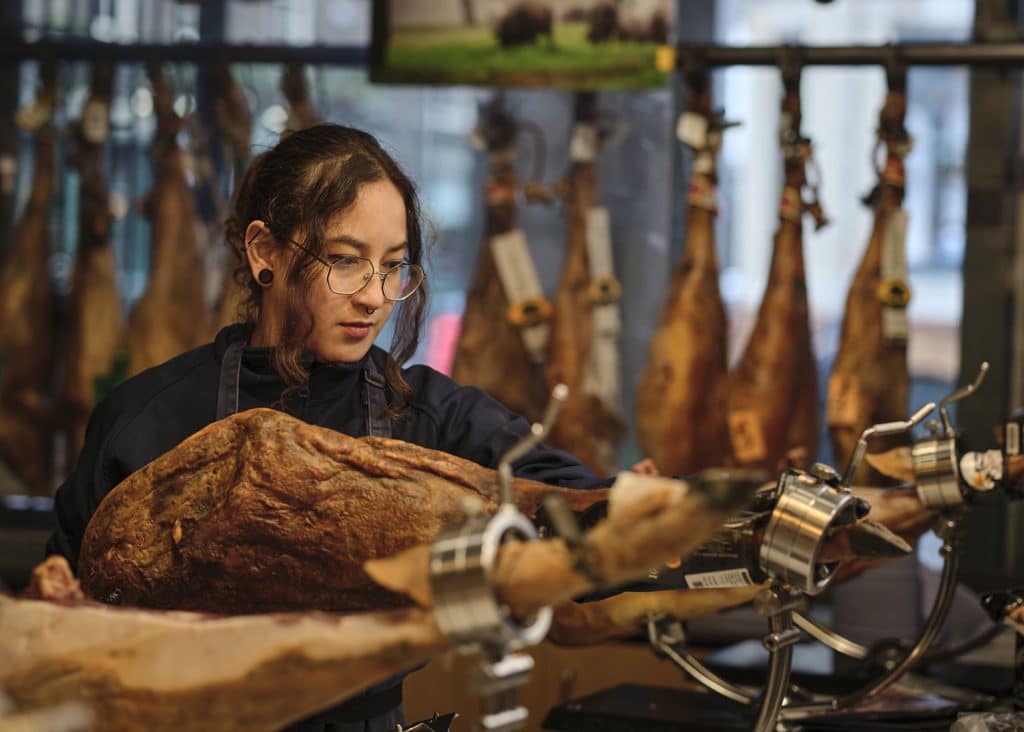

“JAMÓN IBÉRICO IS THE BEST HAM IN THE WORLD. I’M VERY HAPPY THAT SPANISH PEOPLE INVENTED THIS FOR US!”
Interview: Mark Riddaway / Portraits: Orlando Gili
As a first question posed to a young woman with a Spanish name whose job on a Spanish food stand (Brindisa) involves a definitively Spanish craft – hand-carving jamón Ibérico – it seems reasonable enough: which part of Spain are you from? “I’m not from Spain, I’m from Colombia,” replies Manuela Villegas Restrepo. “From Medellín in Colombia.” At Borough Market, nothing should ever be assumed.
Until she landed in London six years ago in search of new opportunities, Manuela had only visited Europe once before. “My sister-in-law is Spanish, so I’d been in Spain for my brother’s wedding in 2015, but only for a month, just holidays, not to live.” She knew nothing of Spanish ham. She also spoke no English: “I just knew that ‘manzana’ is apple. That’s all!” She is now an impressively fluent speaker and a skilled proponent of the delicate art of carving cured meat, her rapid mastery of which she attributes in part to her background as a musician. “I’ve played the violin since I was seven years old,” she says, with an elegant flourish of her arm. “It’s quite similar in some ways – my knife is like my bow!”
Before you came to Europe, had you ever come across jamón Ibérico?
Literally never. For me, it was really weird to see it, because it’s just a massive leg. For a Colombian it’s quite shocking. It’s like: “What is this?” At first, I thought it was raw! But when I started to learn, I fell in love with it. I fell in love with Spanish gastronomy, how they cook, how simple the food is. I love food and I love the stories behind food. How people cook is what makes a culture. To understand a country, you have to understand its food. We speak Spanish in Latin America but the resources are different and the way we cook is completely different.
So how on earth did you end up learning the traditional Spanish craft of the ‘cortadora de jamón’?
When I met with my brother here in London, he found me a job as a ham carver for a company called Enrique Tomás. He works there as a manager. Enrique Tomás is really famous across the world. It’s this guy, his name is Enrique, and he does everything – he has the pigs and produces the ham. When I started to work there, I didn’t like it. You need to have a high level of skill to carve properly and I found it very hard, especially with my lack of English. But I started to read about it, started to familiarise myself with the process, and slowly I got better. I remember they gave me the cheap ham to train on – the serrano ham. Once I got better, I started to go to the higher categories.
The jamón Ibérico you’re now carving at Brindisa is the very highest category of all. What makes it so special?
Creating it is just a long, beautiful process. The carvers are like the top of the tree, making a beautiful plate, but the roots are so deep. It all starts with the pig. It’s a special and unique pig, an Ibérico pig, which can only be found in Spain and Portugal. They’re free range and they have a special diet of acorns. When you see the pigs, they’re huge. They’re semi-wild animals, very impressive. The pig lives for maybe two and half years, and then the process of curing is another three years minimum, so it takes a lot of time and work before I’m here carving a leg.
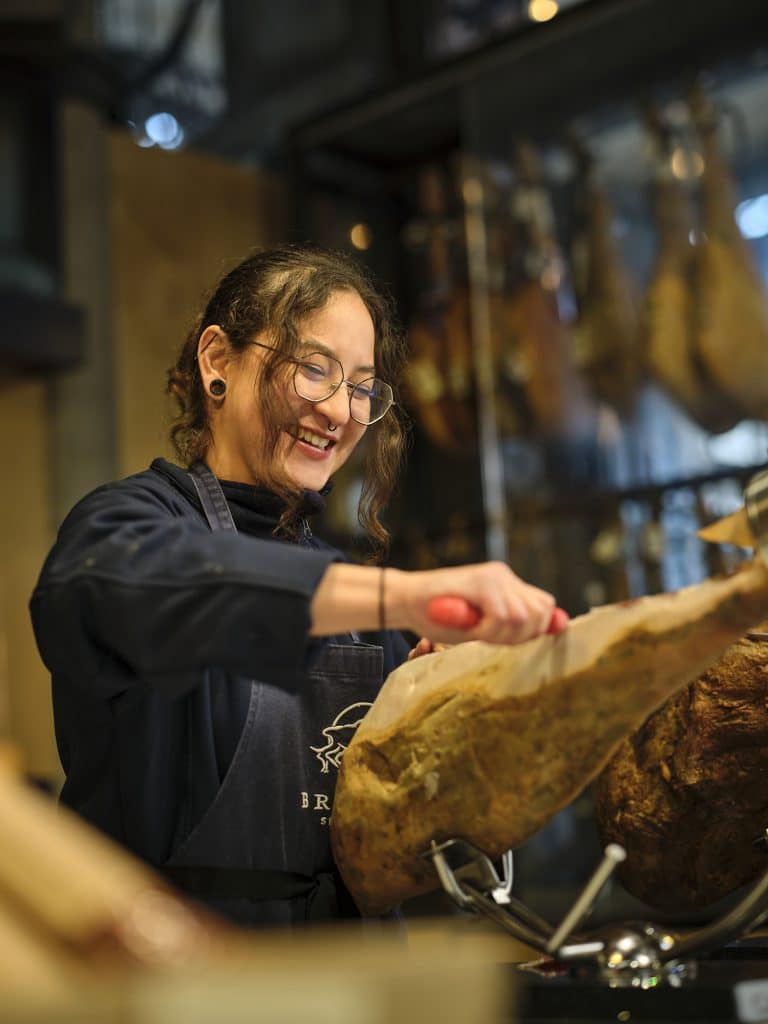
How much variation is there in the flavours and textures within a leg of jamón?
There are lots of different muscles in a pig’s leg and every muscle is different, so the same leg has lots of different flavours. Every leg is different as well: the pigs are free range, so some of them walk more, some of them walk less. We have ham from four different regions, and from every region the ham tastes different. It’s the same type of pig and the same curing process, but the environment is different. We have one farm that is really close to the sea, and you can taste the salty wind in the ham.
What does the perfect slice of jamón Ibérico look like?
My Spanish colleague Eva is a beautiful and special ham carver. Because I’m not from Spain, I’ve been learning so much from her. Her parents told her that the perfect slice will be the size of a credit card and really thin. It’s the perfect size to put in your mouth. It melts on your tongue. It’s like an experience – not just to eat, to enjoy. Because we carve by hand, every piece is unique, and it’s artisanal from the very beginning until the very end. It’s the best ham in the world. I’m very happy that Spanish people invented this for us!
In Spain, yours is a highly respected profession, but also a very male one. You won’t often see a woman carving ham, but at Brindisa there are two female carvers in the same shop. Does it feel good, breaking down those barriers?
Yes, I feel fantastic – because I’m as woman and as well because I’m Colombian. Some Spanish people do get a bit offended. They arrive in the shop and ask: “Whereabouts in Spain are you from?” I say I’m from Colombia and some of them are like: “What? Do you have a license to do this?” No, but I do it, and I do it well and really that’s all that matters. I suppose for them it’s very cultural, very important. And a non-Spanish woman carving ham? That’s just weird!
Brindisa is a company founded by a woman. Do you enjoy working for her?
I love it. Monika, the owner, has made it her mission to work closely with small businesses in Spain, and basically just help them grow, and grow together with them. I really like that philosophy. She’s really inspiring and really humble as well. I love the company, not just for the ham but for every product that we have. Every product we sell is truly artisanal.
There’s an element of performance to your work. How do you find it, being on public display?
Every day I feel like I’m famous! Literally every minute, people are taking pictures. Sometimes it’s fun, depending on your mood. But sometimes, if I’m having a really bad day, it’s quite annoying, so I pull my face really crazy! I’m always happy to talk to people, though. They get really interested in what I’m doing and about the ham, asking lots of questions.
Do you enjoy being in the market every day?
Yes, I love working in a market. The aromas and the colours and the noise – it’s really magic. And you make those connections with so many different people. It’s like living in a big house. The only thing is the weather. The weather is awful. As a Colombian, it’s really challenging! In the corner where Brindisa is, we receive currents of wind from every single direction. And the floor as well: the cold comes up through your feet when you’re standing there for eight hours! But then the summer comes and it’s warm, and when you finish work it’s still light. Then it’s really beautiful.
IWD
Coffee with a conscience
How Borough Market’s coffee traders are working hard to create meaningful change, both at home and abroad
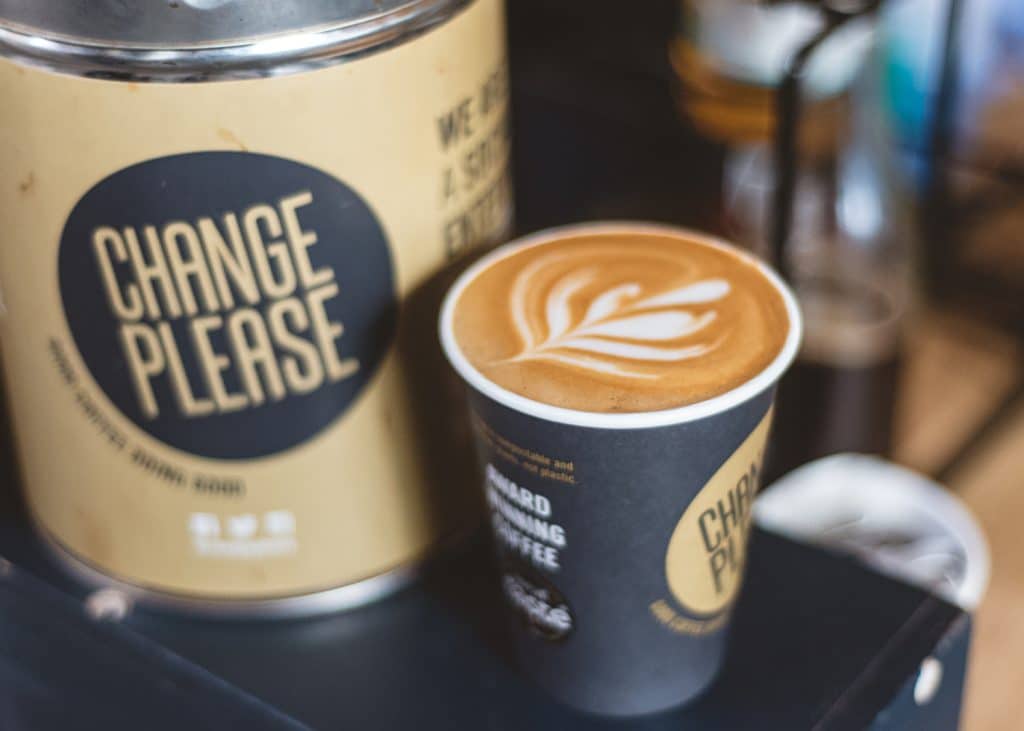

“REGARDLESS OF WHAT THE COMMODITY MARKET IS DOING, ONCE WE’VE SET A PRICE, IT NEVER GOES DOWN”
Words: Tomé Morrissy-Swan
Britons are drinking more coffee than ever. The number of coffee shops more than doubled between 2007 and 2018 and continues to rise, with cafes set to overtake pubs by 2030. Whether brewed at home or bought from a specialty coffee shop, for millions of us, no day goes by without a cup.
But, like most global commodities, coffee faces several threats. Climate change is threatening harvests with droughts and floods. In Brazil, the world’s largest producer, a late frost in 2021 severely damaged yields, pushing prices up around the world. Recent weather-related shortages have seen prices soar to a near 50-year high. On the social side, producers often see meagre financial returns.
But many coffee companies in the UK are striving to do things better, whether buying sustainably grown coffee and paying farmers a premium or using coffee as a way of effecting social change in Britain. Here, two Borough Market-based coffee shops explain their approach to serving coffee with a conscience.
Monmouth Coffee Company
Environmentally speaking, coffee is a high-impact product – and a luxury at that. It is grown in large quantities, heavily processed, transported around the globe, packaged (possibly several times), and requires the boiling of water for each cup. “If you look at the carbon footprint of beef and cheese, coffee’s not far below that,” says Finn Andres, Monmouth Coffee Company’s sustainability lead.
Monmouth has been selling coffee since 1978. From working with small farms ideally using environmentally friendly methods, to using renewable energy at its cafes, it tries to do things the right way, says Finn.
Monmouth’s core principles are quality, transparency and being socially sustainable. The coffee must be of a high calibre; they must know where it has come from; and they strive to “pay farmers properly”.
That begins with working closely with producers. As a commodity, the coffee market is volatile, and growers are often paid poorly. Monmouth has long used a direct trade model, establishing close relationships with farmers, mostly in Latin America or Africa, and making long-term price commitments. “They can be sure that, regardless of what the commodity market is doing, next year they have this price, normally well above the commodity price,” Finn explains. “Once we’ve set a price, it never goes down.”
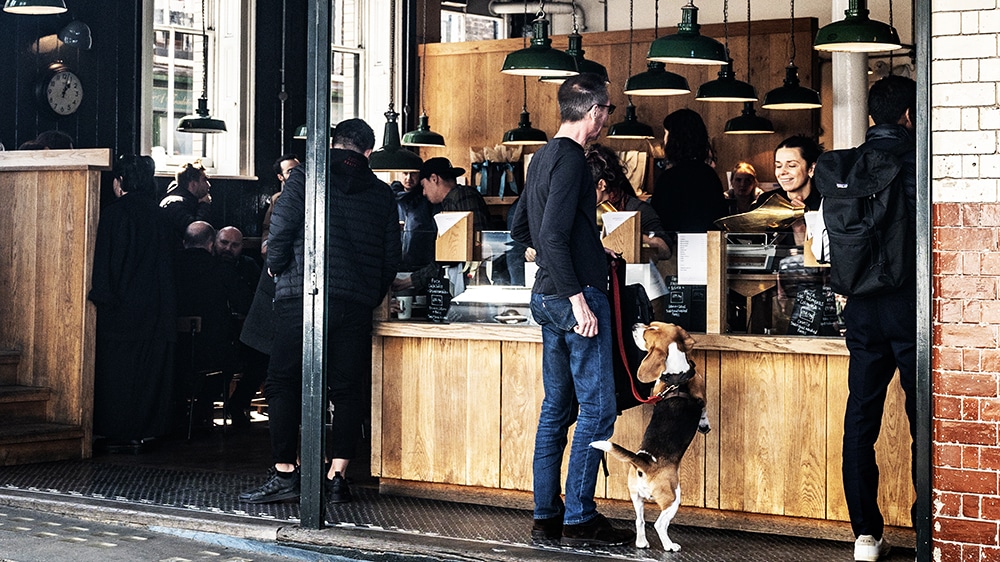
Transport is the next hurdle. Monmouth’s coffee arrives via container ship which, though using diesel, is “by far the lowest-impact way”, short of sailing ships. In the UK, Monmouth exclusively uses electric vehicles and its premises are run on renewable energy where possible – the roasters, currently, are gas-powered. Milk is purchased from a Somerset farm with “very low impact for dairy – but it’s still dairy,” says Finn.
Packaging is Finn’s biggest bugbear, and the hardest thing to get right. Coffee requires a barrier to protect it from the elements; it would spoil quickly in a paper bag. Monmouth’s packaging is not currently recyclable. “Our packaging needs to change, it can definitely be improved,” Finn admits.
Arguably the business’s biggest recent change has been doing away with disposable cups. Around 2.5 billion are used each year in the UK, with millions thrown away – very few are recycled – each day. Since 2022, customers have had to bring their own, drink in, or pay a £5 deposit for a reusable cup, which can be swapped for another on their next visit. It has gone down “surprisingly well”, says Andres, and has barely impacted sales. “In terms of how quickly customer behaviour changed, it was really fast.” Several cafes have been in touch for Monmouth’s help in following suit. It shows how small changes can soon make a big change.
Change Please
It all started in 2015 with a coffee cart in Covent Garden. Founder Cemal Ezel had been away travelling and, on returning to London, was struck by the levels of homelessness he saw. According to Crisis, the number of people sleeping rough in the UK in 2023 was 120 percent up on 2010. Change Please is fighting it.
The social enterprise trains people experiencing homelessness to Speciality Coffee Association standards, with a dedicated academy in Peckham and 10 retail sites across London. It has helped hundreds earn the skills to enter employment.
Candidates are referred to Change Please by bodies including the NHS or charities. They undertake a 12-week programme including barista training at one of the London cafes – including Borough Market. Trainees are paid the London Living Wage and given support with everything from mental health to housing. All profits go towards funding the programme.
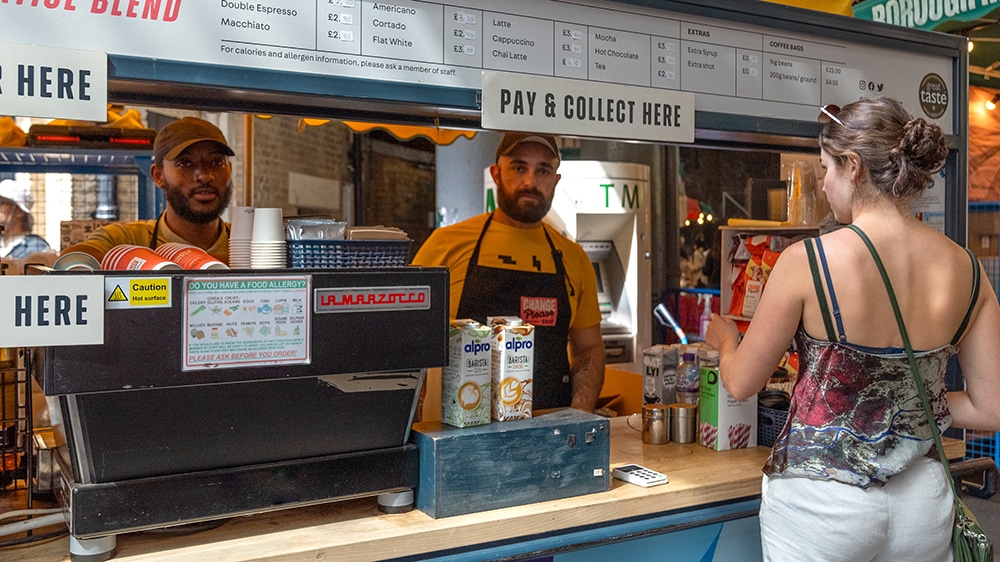
The social enterprise also runs the Driving to Change initiative. A repurposed double decker bus visits London boroughs, working alongside councils to provide support, from dental care and banking assistance to a coffee and a chat. Last year it made 4,000 trips, provided 1,091 haircuts, 878 dental visits and gave out 84 mobile phones. It also refers candidates to the barista training scheme. “It’s a vital service that goes out every day of the week,” says Tara Cunningham, Change Please’s head of marketing.
For Tara, coffee is an especially good medium for training. “Anyone can be taught it, you don’t need any prior experience,” she explains. “It teaches many other skills. As well as barista skills, it’s very interactive – you’re speaking to people, dealing with the public, working with the team.”
In 2024, 231 people went through the barista programme, 54 moving on to full-time employment. While many work as baristas, others have moved into other roles, including in IT. Tara believes a lot more can be done on a national level to tackle homelessness, but “we think that empowering people to get back into employment is the right way to do it”.
Explore our coffee recipes
A love supreme
Marie Mitchell on why Valentine’s Day is a perfect time to appreciate the people who grow and sell our food
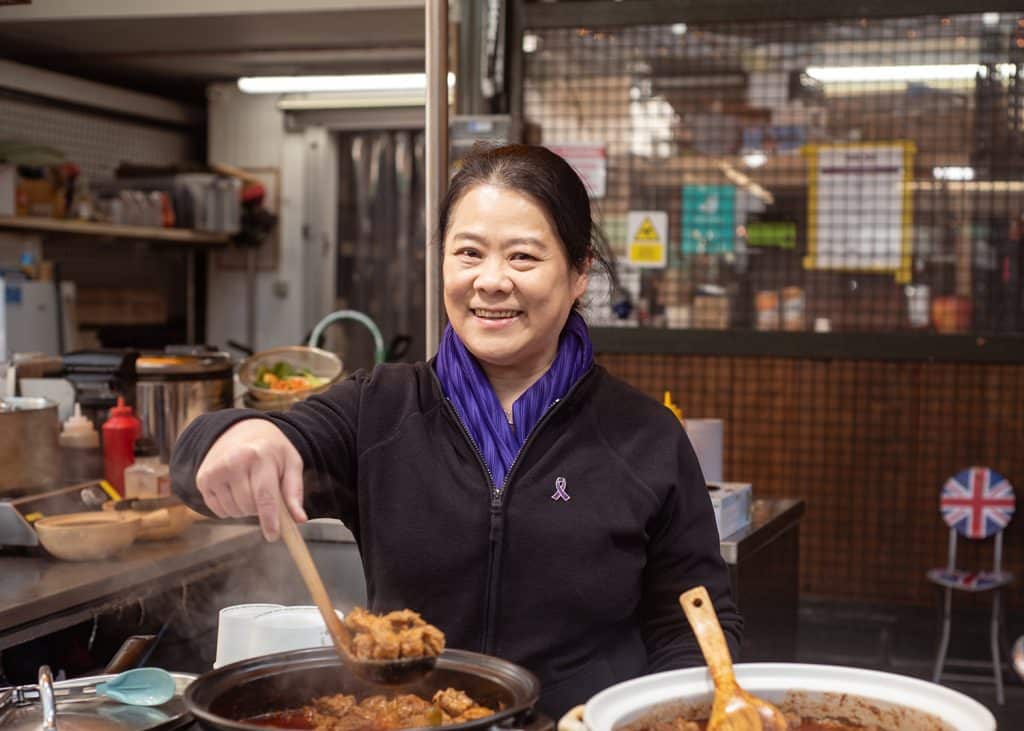

“IT IS APPARENT TO ALL OF US WHO ARE LOVERS OF FOOD THAT THE GREATEST PLEASURES ARE EMBEDDED IN THE ACT OF SHARING”
Words: Marie Mitchell / Images: RED Agency, Sophia Spring
The loom of Valentine’s Day often fills me with dread. Not for the fact that it’s a day to celebrate love – I’m drawn to that like a moth to a flame – but because of the pressure placed on romantic couples to showcase their love in the most fleeting of ways, as if this were the only day to do so. Love bound in respect, appreciation and community is the kind I root for; love that builds memories and lasts a lifetime.
Usman Shah of Date Sultan believes in “love at first bite”, with his first being that of a date – a custom in his household and a wider Islamic one, where a baby’s first taste should be of something sweet. Clearly that bite did last a lifetime, as Usman is now the proud owner of Date Sultan, a social enterprise at Borough Market that imports dates from Egypt, Jordan, Palestine and Saudi Arabia.

His parents used to send Usman out to gift dates to passers-by, believing that the more you gifted others, the more that kindness would make its way back to you. This sentiment now provides the framework of his business. Usman works directly with farmers to tackle modern slavery, a practice deeply entrenched in date farming (and many other forms of agriculture around the world). Having grown up in Newham, east London, Usman also uses his business to give those closer to home job opportunities, seeking to employ local people who’ve previously struggled to gain work. The trickle-down effect of trust and appreciation from consumer to producer has helped Usman build a community in which everyone benefits.
Friends, family and community is what motivates me in my work – and it’s also what has helped Salina Khairunnisa’s Malaysian food business, Joli, go from strength to strength. In 2009, after being made redundant during the worst global recession in almost a century, Salina (pictured top) turned to food to support her family. A charity event selling the garlic and chilli oils she made at home, led to her selling them through her children’s music school. Later, after sending her products to the Guild of Fine Food, she had her first taste of market life.
While Salina worked other jobs to provide for her children, it was the generosity of her friends and neighbours, for birthdays and Christmas’, that helped her gather the tools and equipment she needed to slowly build the business. A couple at Dulwich farmers’ market gifted her their tables, weights and canopy, as it was their last day of trading. This allowed her to expand to a second stall, building on the success of the first, leading to an invitation to cook and trade at Borough Market for the 2012 Olympics.
Salina chose to cook Malaysian food – the food of home – for the simple reason that she missed it. When she first moved to London, she relied on her family to send letters with recipes so she could learn how to cook the food herself, and waited for their yearly visits, when they’d bring spices and other ingredients with them. All of this is embedded in the evolution of Joli, with both family and friends being integral to its story. Salina still has those letters sent by her mother and grandmother: these beautiful, tangible pieces of cross-generational learning, love and support.
It is apparent to all of us who are lovers of food that the greatest pleasures are embedded in the act of sharing. How else do those moments of taste become traditions? How else do the seasonal shifts and what we make of them become celebrations? My love for the Island of Grenada is felt deeply within my own work and it’s where the products found on the De La Grenade stand are made. They are imported by Doreen Gittens, who upon tasting the products some 15 or so years ago immediately wanted to support their maker, Sybil La Grenade, by bringing them to England.
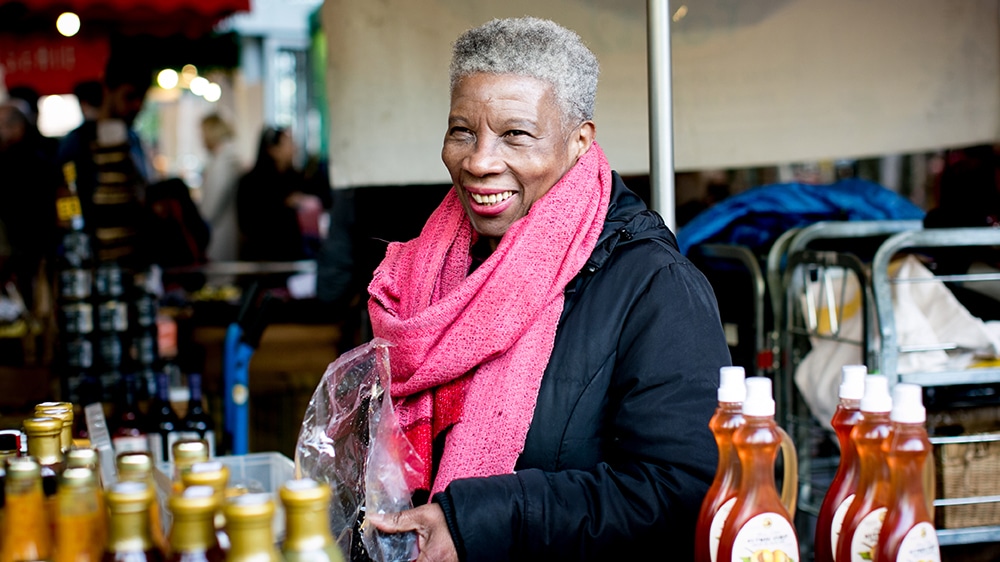
Doreen wanted to showcase the products of De La Grenade not only because they were good but because they were steeped in family history – a business being run by a black woman who was doing it on her own, while also bringing up a family and working another job. The spice isle, as Grenada is known, is a treasure trove of spices, and the De La Grenade products are packed with these treasures. On seeing my first ever nutmeg in the flesh and learning from Doreen how the jams, jellies and syrup are in fact made from the fruit, not the seed we’re used to seeing in spice jars, I immediately felt a yearning for Caribbean flavours. Guava jam is one of the comforting, homely flavours that place me in the first kitchen I knew in all its intricacies. There are water crackers, and mum is spreading the guava jam on them for us as a snack. That is love. That moment, all those moments, are forever in mind.
The love of food – and the love of sharing food – extends far beyond any single day. But Valentine’s Day, if we let it, might be an opportunity to think about the people who grow, pick, transport, cook, package and sell our food. To recognise the love and dedication they pour into delivering it to us, and how we might in turn share that love with our favourite people.
Q&A: Stephen Lucas
The manager of The Tinned Fish Market on artisan canneries, seasonal time capsules, and the parallels between tinned fish and good wine
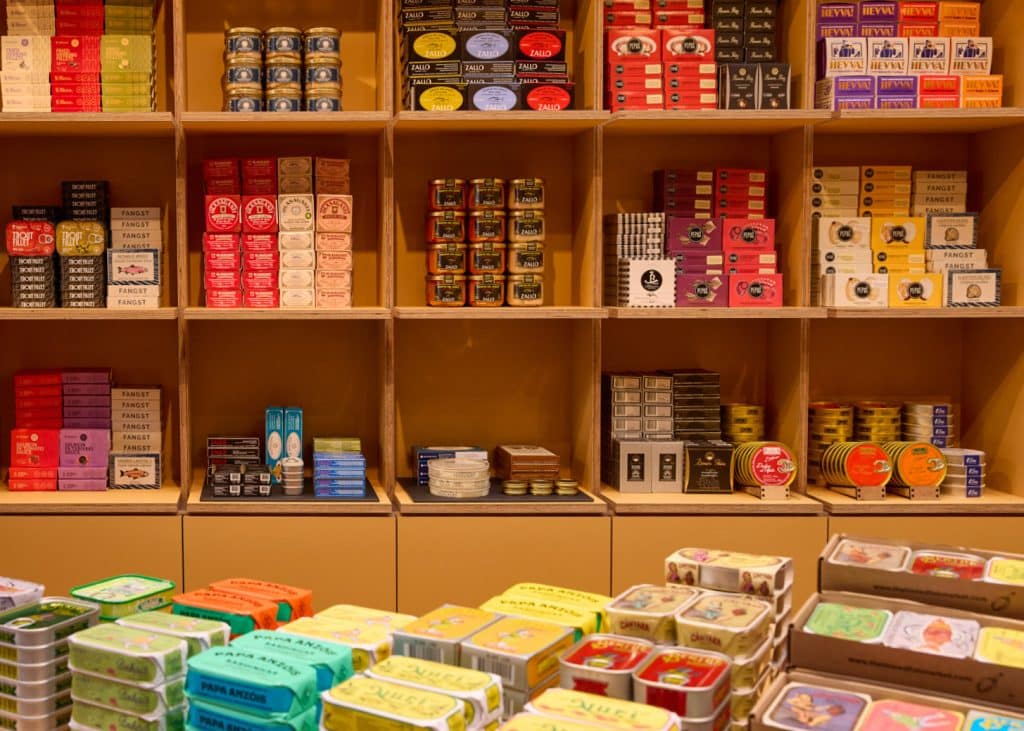

“EACH MORNING, OUR PRODUCERS CHOOSE THE VERY BEST FISH – THE ONES WITH FIRM FLESH, BRIGHT EYES, BRIGHT RED GILLS”
Interview: Mark Riddaway / Images: Patricia Niven
In 2018, when Stephen Lucas was approached by his friend Patrick Martinez with a business idea, his initial response was one of mild scepticism. “Patrick had rented a space in a market in Liverpool, where we lived, and we were discussing what to sell there. Being from Spain, he knew about tinned fish so knew it could be a gourmet product. Whereas I did not. I was like: ‘Tinned fish? Really?’”
A mouthful or two was all it took to turn Stephen’s world upside down. “As soon I tried the Pinhais spicy sardines, I completely changed my tune.” The Tinned Fish Market, which started on Merseyside with two suitcases of cans flown back from the Iberian Peninsula, is now headquartered in Bermondsey, the historic home of the British canning industry. Its beautiful Borough Market stand, run by Stephen, has become a magnet for lovers of tinned fish – and for other mild sceptics willing to be converted.
Tins from Spain and Portugal feature heavily, handmade in small batches using seasonal fish from the Algarve, the Azores and the Cantabrian Sea, but these have since been joined by products of a similarly stellar quality sourced from around Europe. The big-hitters of the tinned fish world – anchovies, sardines, tuna – are all available in a wide range of styles and flavours, alongside cans with contents of a more niche character, from Galician garfish and goose barnacles to Icelandic monkfish livers and Cornish squid.
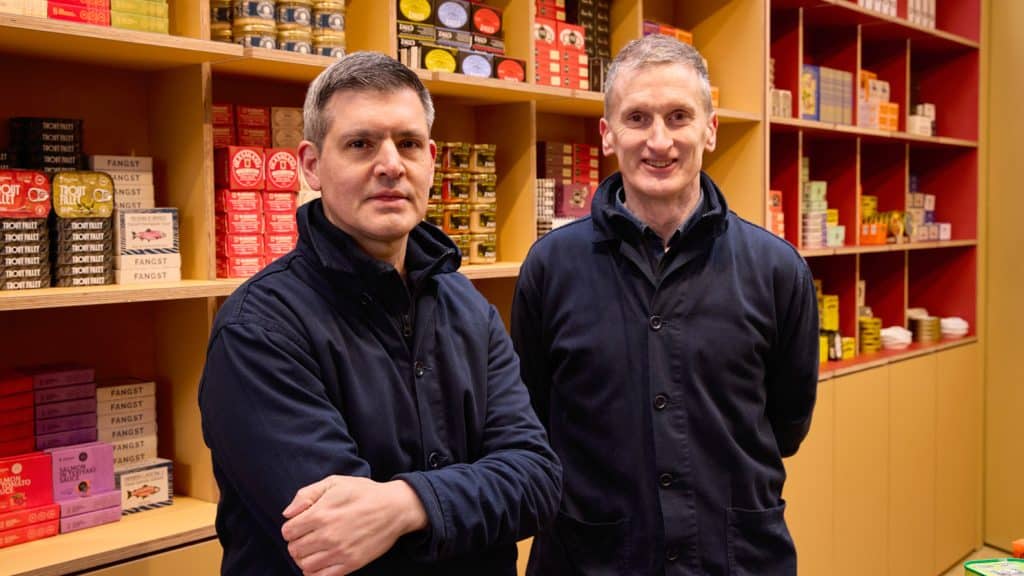
In the UK, tinned fish doesn’t have the best of reputations. Why is that?
Most people here are only familiar with mass-produced tinned fish. You’ll find mass-produced stuff in Portugal and Spain too, but those countries also have this thriving culture of high-quality tinned fish. Our job is to explain what makes these products special, and why they cost more than those 60p supermarket tins. Each morning, our producers are choosing the very best fish – the ones with firm flesh, bright eyes, bright red gills, all those important markers. Over here, canning has tended to be a way of using up the fish that don’t meet those benchmarks.
Beyond preservation, what are the benefits of canning good fish?
There’s no clock ticking with tinned fish, so you can eat it whenever you want, but it’s much more than that. It’s about the flavours. Like wine, they really do get better with time, becoming richer and more complex. At Pinhais, a cannery in Portugal, they mature their sardines for six months before they’re even released. They’ll continue to improve in your cupboard. You just need to make sure you turn the cans from time to time so that the fish are regularly coated in oil.
How old are the canneries you work with?
The oldest has been around since 1857. Quite a few have been around for at least 100 years. Salvatore Orlando of Olasagasti was one of the pioneers – he came to Spain from Sicily in the late 19th century, bringing with him a salting technique that worked perfectly with the amazing anchovies from the Cantabrian Sea. There are new canneries as well, particularly in the Algarve. Papa Anzóis is one. They told me that the last thing Portugal needs is more sardines in olive oil, so they’ve done something new: they’re dehydrating the fish first, which means they absorb more oil and become even juicier. They still use some of those 100-year-old techniques, but they’re melding them with new ideas.
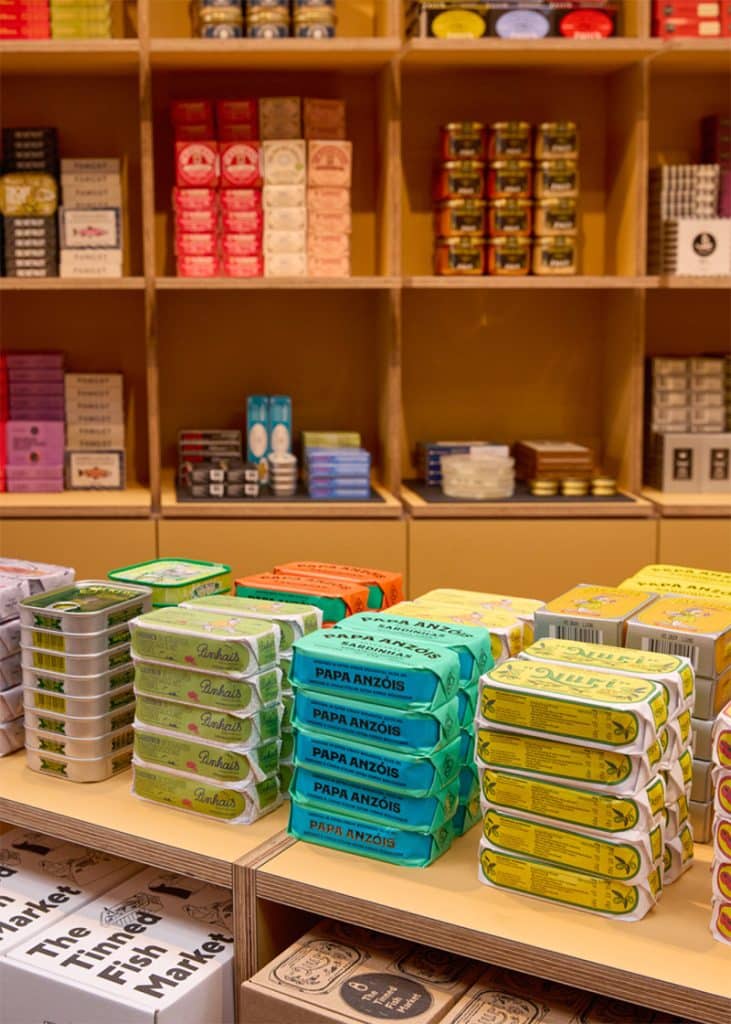
You source from canneries all over Europe. What characteristic do they have in common?
They only use high-quality ingredients – the fish, but also the oil and flavourings – and they still work by hand. There came a point in history when it became much cheaper to mechanise everything, but these canneries have stubbornly kept to the artisanal techniques. You see them in the factories beheading and gutting the fish in a single movement – it’s so fast, it looks like sleight of hand. The fish are also placed in the tins by hand. They can cut them in a way that minimises waste, and it looks so beautiful when you open the tins, all carefully arranged.
Are we starting to see a revival of artisanal canning in Britain?
We are. One nice story is Hevva! – a new Cornish cannery. When they were getting started, they came to us asking for tips on what would do well in the British market, and we gave them some advice on their products and packaging. Theirs are now some of the most popular cans on our stand. And some of the most luxurious tins that we have are from Exmoor Caviar in Devon – so yes, it’s definitely happening here now.
What are your suppliers doing to protect the oceans?
Our canneries work at a small scale using sustainable fishing practices such as pole-and-line fishing and ‘purse seine’, a type of net that allows smaller fish to escape. They fish seasonally to avoid overfishing. Tinned fish is like a little time capsule – you can eat seasonally all year round. The albacore tuna is only fished for four months over the summer. Anchovies are caught in the spring. Striped red mullet is caught for a single month in late summer. Sardines are fished from May to November, and if the quota’s met before that November cut-off, then the boats have to stop. It’s all entirely traceable: we get a catch certificate which says where they’re caught, which boat caught them, the weight of the catch. If somebody wanted to know where the contents of a can came from and when, we’d be able to find that out – every single can.
One thing that’s immediately obvious to anyone visiting your stand is the quality of the graphic art on the cans. How big a draw is that?
It’s funny the number of people who stop by for that reason. We get graphic designers dropping by just to look at the tins. We even get vegans coming in to appreciate the art! Some of the artwork has real heritage – the Berthe design, with the little girl, that’s from 1906. Others are modern – the amazing Papa Anzóis branding, for example, with its bright pops of colour. Those designs draw people in. Their look is what’s so arresting when you pass our stand, and maybe what persuades people to buy them initially. After that, though, it’s more about the flavour and less about the aesthetics.
How close is your relationship with the canneries you buy from?
A lot of them have been on a real journey with us over the past six years and we’ve got to know them really well. Pinhais has been with us right from the start. We’ve been with Olasagasti a long time. Don Reinaldo, too – they’re just five people working in a tiny cannery in Galicia. I remember when some of their tins were featured on the Sorted Food channel on YouTube. Their videos have huge reach in the UK, and suddenly everyone here knew about this tiny Spanish cannery. People were flooding to our store wanting monkfish livers. The cannery had to do a whole extra batch just for us because it was so popular! They were so excited. It was lovely to see.
Q&A: Mark Oakley
The Dean of Southwark on the meaning of Christmas, the importance of sharing food, and the joys of Boxing Day cheese
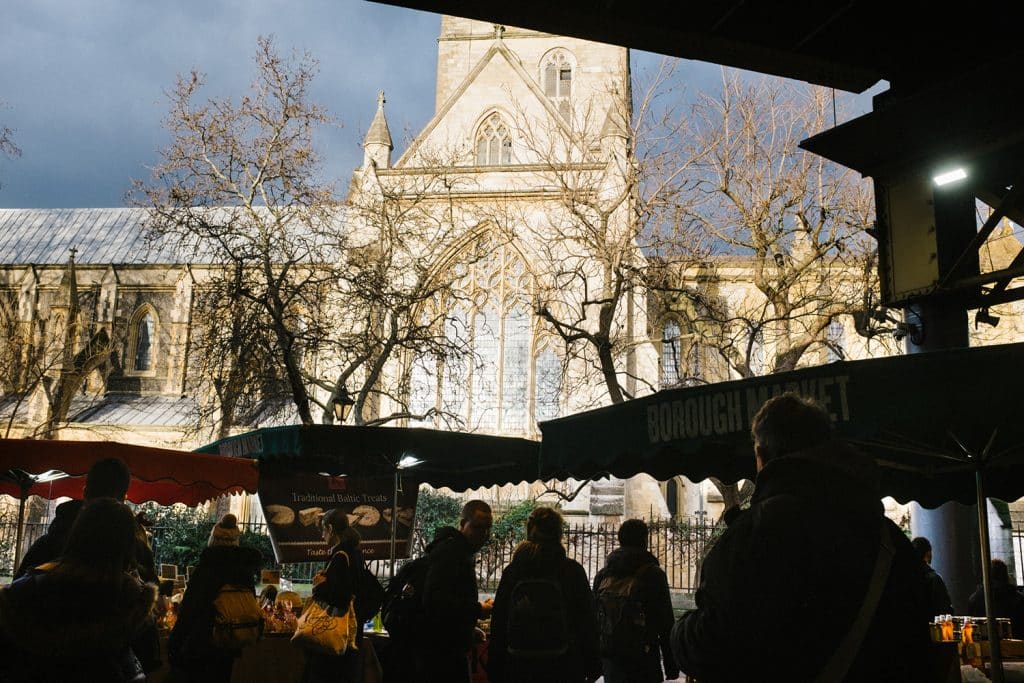

“HUMAN BEINGS ARE HUNGRY FOR RELATIONSHIPS, AND SHARING FOOD IS ONE OF THE WAYS IN WHICH THAT HUNGER IS FED”
What’s your history with Borough Market?
I’ve studied and then worked in London for most of my life, apart from periods in Copenhagen and Cambridge, so have known the Market since I was 18. I loved it from the minute I found myself in it. I love good food and produce, always wanting to support local growers and non-chains, so it was exciting, engaging, and a place I always brought friends and visitors.
Does the Market’s approach to food chime with your own?
I do care about supply chains, about the need for healthy and nutritious meals, especially for children, and I get very angry about food waste. I’ve always liked American food writer Michael Pollan’s comment that if it came from a plant, eat it, but if it was made in a plant, don’t. Having been visiting some food banks and soup kitchens lately, I’m also very aware of food poverty in our city and keen to think through how such a locality that celebrates food so deeply can help more.

The Cathedral and Market have been neighbours for centuries. What do you think these two historic institutions have in common?
Well, I suppose in our different ways we are both about nourishment – body and soul. It is significant that the main service in the Cathedral is based around the sharing of food – bread and wine – and that we believe that the way each receives an equal sharing at the service is how life should be outside the church doors: an equal share, with each being valued, equal in dignity and potential. When food is shared in families and among friends, it becomes more than nutrition. It is a shared symbol of togetherness that enables us to grow towards each other, sometimes with joy and sometimes in pain. Human beings are hungry for relationships, and sharing food is one of the ways in which that hunger is fed. At its best, faith is another.
What is it about Christmas in particular that makes food such an integral part of the celebrations?
At Christmas, Christians celebrate our belief that Jesus is the human face of God. Christians believe that God became human, and so understands us from within, and so Christianity takes bodies seriously. It also takes relationships seriously, and so sharing food is central to its celebration of ‘incarnation’. At a time when many are trying to be great examples of power, we need to see again the greater need for the power of example. By sharing what we have and looking out for those who do not enjoy what we do, an example is given of a kindness and generosity that society so urgently needs to reclaim.
How busy a period is this for you?
Very busy! We have so many carol services, I joke that it is “death by Little Donkey”. Seriously though, I love Christmas, especially the services on Christmas Eve and Christmas Day, and the glass of champagne I have as soon as I get home. I toast all those I have lost in life and who meant so much. This year I lost my grandmother, who brought me up, and I will miss her deeply, as she adored Christmas too.
What are your own favourite Christmas foods? Is there anything specific you’re intending to buy from the market traders?
I love a goose at Christmas! I also really love Christmas pudding. I like some cheese on Boxing Day as I recover from lunch the day before, so I’ll be on the prowl for some nice goat’s cheese and a good bit of blue. Have a great Christmas!
On the second day of Christmas…
Gurdeep Loyal sets out to turn Christmas leftovers into crispy, golden pastries
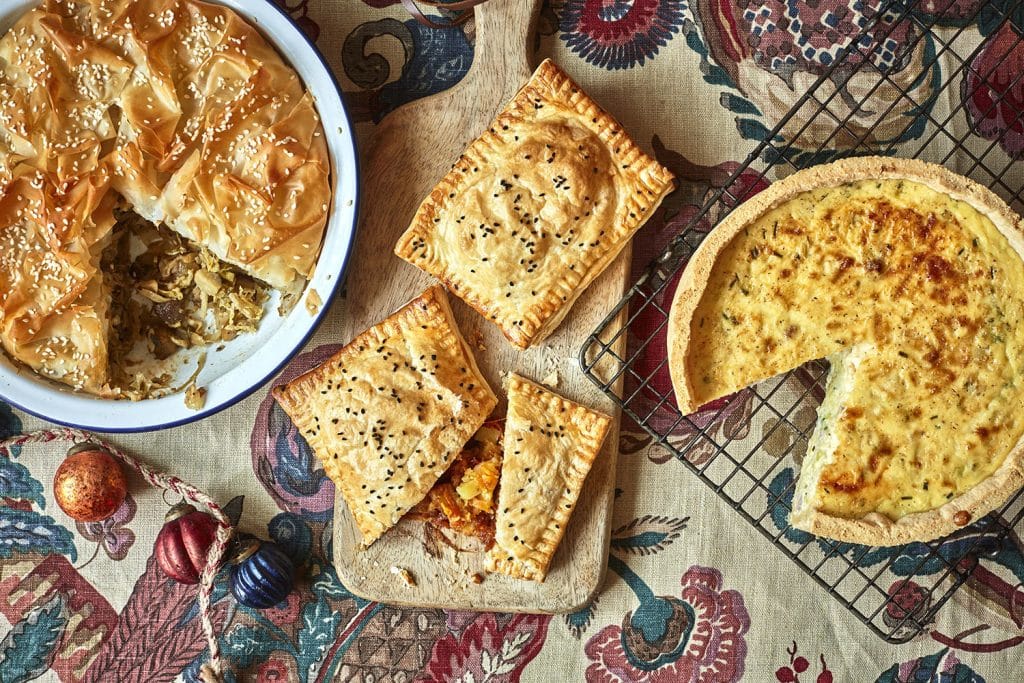

“DON’T THINK OF LEFTOVERS AS ‘EXTRA FOOD’ THAT NEEDS USING UP, BUT AS ESSENTIAL INGREDIENTS IN THEMSELVES”
Words: Gurdeep Loyal / Image: Stuart Ovenden
The season of festive plenty is also the season of plentiful leftovers – which with daunting speed can fill up the fridge and freezer quicker than you can open the windows of your advent calendar. The trick is to not think about them as ‘extra food’ that needs to be eaten up somehow, but as essential ingredients in themselves that can enliven other complete dishes.
Leftover cheese
The festive cheeseboard has the potential to be transformed into countless different delectations. My favourite is Christmas pasties, which have the added benefit of using up any leftover chutney, quince jelly or other condiments. I made mine with Sparkenhoe from Neal’s Yard Dairy – a raw cow’s milk cheese, it has a rich nutty taste and melts wonderfully – and a traditional sharp clothbound Pitchfork cheddar made in Hewish, north Somerset by Trethowan Brothers. You can also add in leftover soft cheeses, such as The French Comte’s creamy brie and buttery Domaine de St Loup Normandy camembert. These pasties really do work with any festive cheese accompaniment you might have, such as Northfield Farm’s banquet of Tracklements chutneys, all of which are fantastic, or Pimento Hill’s Festive Chutney, bursting with cranberries, plums, spices and port. Adding a splash of tangy vinegar to the filling amplifies all the flavours to a new level. I love the Biologico Malpighi balsamic from The Olive Oil Co: tart, vibrant and well balanced. Melted together in crumbly, oven-warm pastry, it all amounts to a festive hug on a plate.
Festive cheese & chutney pasties
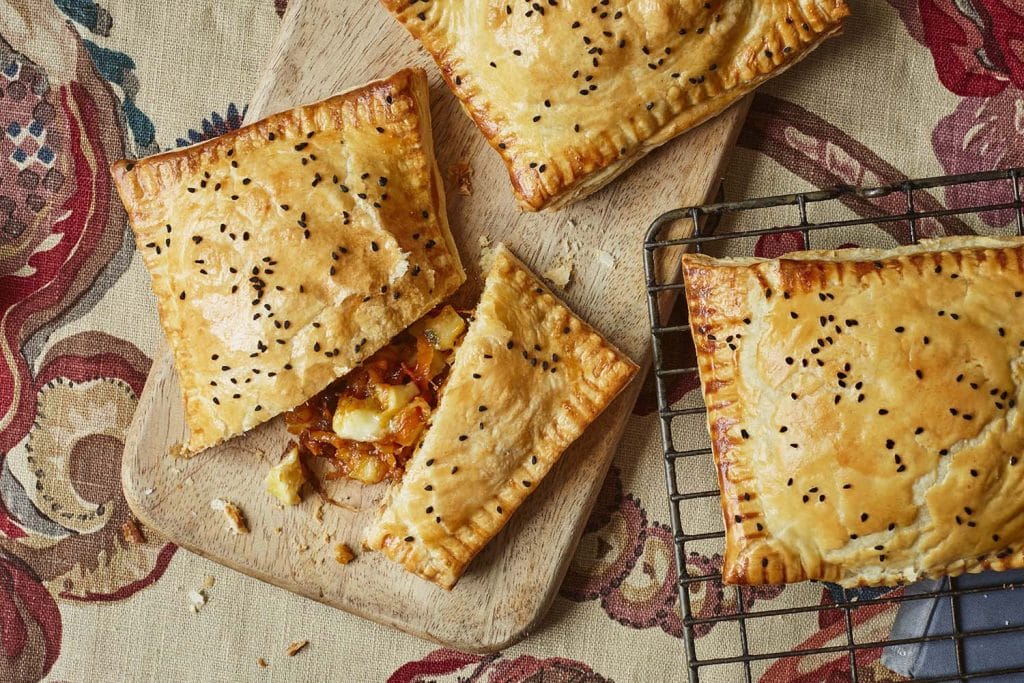
Leftover bread sauce
Leftover bread sauce is among the first things to be devoured at my Christmas table, but in the unlikely event that you do have any spare, it’s wonderful added to the savoury custard filling of a quiche. This is also a lovely way to use up any leftover charcuterie. I adore the flavour-packed Spanish hams from Brindisa, like their smoky-salty Leon serrano or sweet, fresh-tasting Galician roast ham. You always want a strong robust cheese with any homemade quiches. The toasty, tangy Oude Beemster gouda from Borough Cheese Company is ideal for this, or for something a little different try their Olde Remeker, a paler, intensely creamy cheese aged for 13 months. Alternatively, head to Une Normande à Londres for a sharp, fruity gruyère or nutty Jura comté vieux. The bread sauce brings everything together, adding an additional layer of savoury flavour and a pleasing grainy texture to the set custard filling. This is delicious hot or cold: serve with a peppery green salad, a simple mustardy vinegarette and dollop of chutney on the side.
Smoked ham, gouda & bread sauce quiche
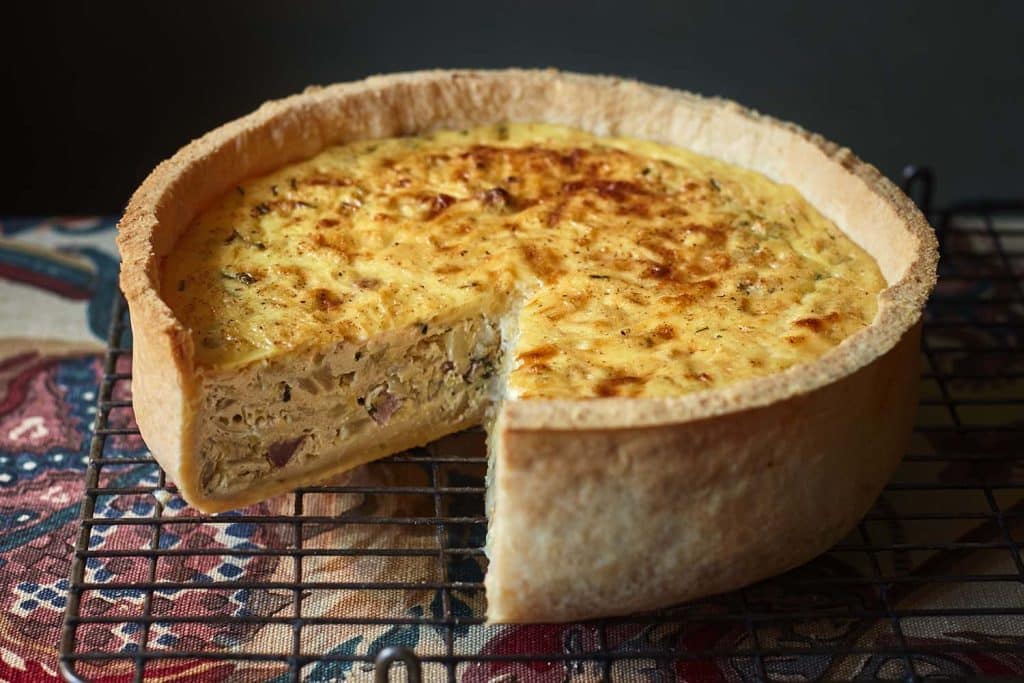
Leftover veg
A filo pie filled with leftover vegetables makes the perfect centrepiece for any vegan guests over the festive period. This recipe has a shattering, crackling pastry exterior, and rich savoury veg-packed filling. Brindisa’s cooked sweet chestnuts are perfect here – grown in Galicia, Spain’s mecca for chestnuts, they have a sweet, intensely nutty flavour and rich, buttery texture. Alternatively, try the roasted Kentish cobnuts from Food & Forest, with their grassy, hazelnutty bite. For something a little more unexpected, you could even add a pinch of lavender from Le Marché du Quartier, some finely grated lemongrass from Raya or even a sprinkle of za’atar from Arabica to the mix.
Parsnip, chestnut, sprout & sage filo pie
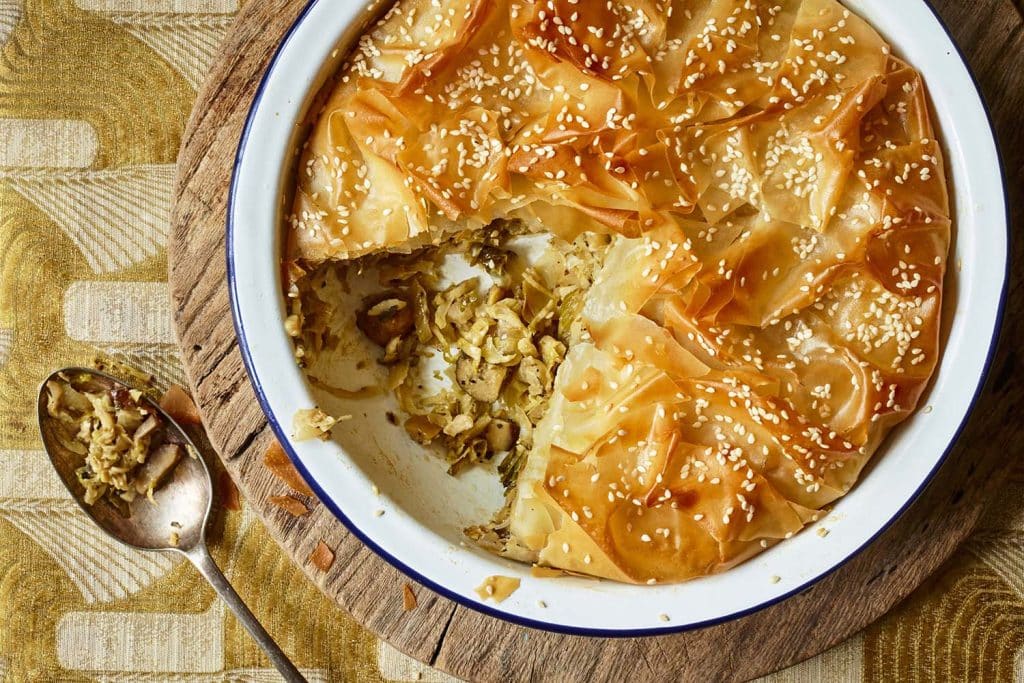
Small wonders
Gurdeep Loyal sets out to create the perfect canape selection for the festive season, using Borough Market produce


“THE BEST CANAPE PACKS A PUNCH OF UNCOMPROMISINGLY LOUD FLAVOUR, PRIMED TO GET THE PALATE PARTY STARTED”
Words: Gurdeep Loyal / Image: Stuart Ovenden
Being a good host is all about knowing what your guests might desire before they’ve realised it themselves. With this in mind, greeting them with a seasonal tipple and astonishingly delicious nibble at the door is the definition of festive hospitality. With canapes, there are three golden rules: offer something that’s easy to hold with one hand only; sized to provide two satisfying bites; and packs a punch of uncompromisingly loud flavour, primed to get the palate party started. My take on three party classics will do just that.
Devilled eggs
Devilled eggs, a well-loved party favourite in the 70s and 80s, have had something of a revival in recent years – with all sorts of global iterations perking up this joyful retro classic. This Japanese-inspired take brings in Asian flavours with unapologetic gusto and will go down a storm at any seasonal bash. 13 Acre Orchard has the perfect organic eggs for these: fresh from the nest, with sunshine-yellow yolks thanks to the range of grasses the free-roaming chickens feed upon. Head to Spice Mountain for some miso and wasabi, both of which add pleasing punches of flavour. It’s the shichimi togarashi Japanese spice blend that’s the true hero of these mini bites, though, combining white and black sesame seeds, sancho pepper, orange peel, chillies, seaweed and ginger. It’s best to make a double batch of these from the get-go. They really are a party on the palate!
Sizzled spring onion & togarashi devilled eggs
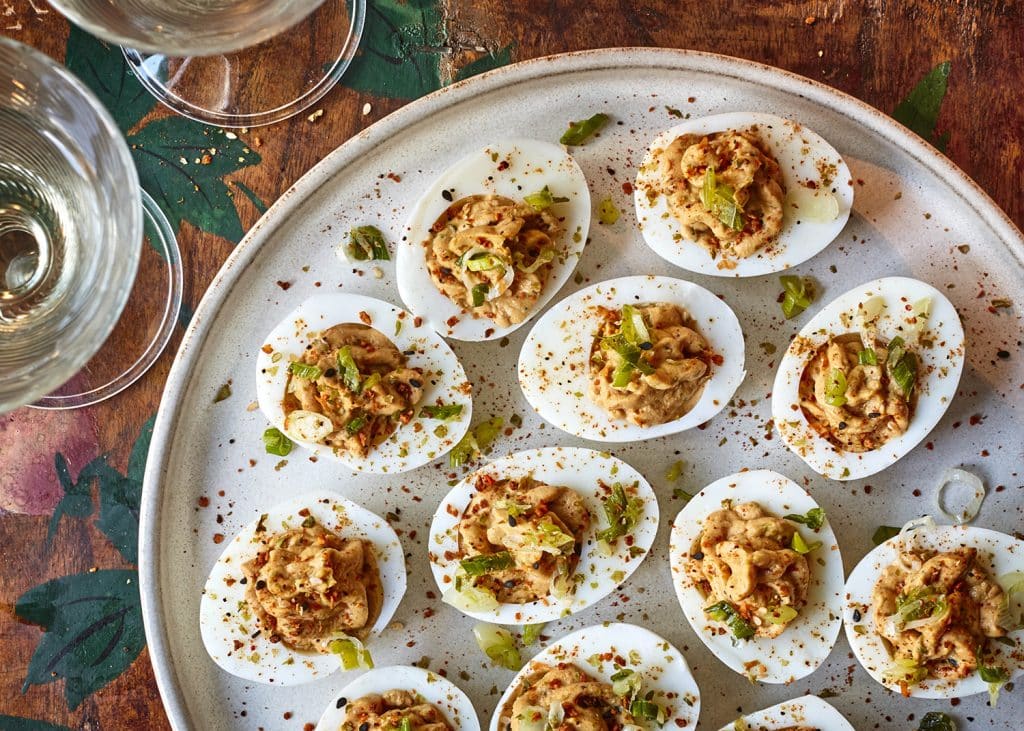
Cheese straws
The only thing more suited to a celebratory martini than a briny olive or cured anchovy from Brindisa is a home-baked cheese straw – far superior to those you can buy in shops. These crumbly, savoury biscuit batons are perked up with zhug from Arabica – a fresh, verdant Yemeni chilli paste, rich in coriander, green chilli, cumin, clove and cardamon. Alternatively, use fresh harissa from Borough Olives, made with hot chillies, garlic, caraway, paprika and rapeseed oil, or the deliciously warming chimichurri sauce from Porteña. Sparkenhoe from Borough Cheese Company is a great base cheese for these straws, particularly with the addition of some Red Cow parmesan from Bianca Mora, aged for 24 months for a rich, savoury flavour. For an extra touch of spice, add in some earthy, toasty, brick-red smoked paprika from Spice Mountain.
Zhug cheese straws
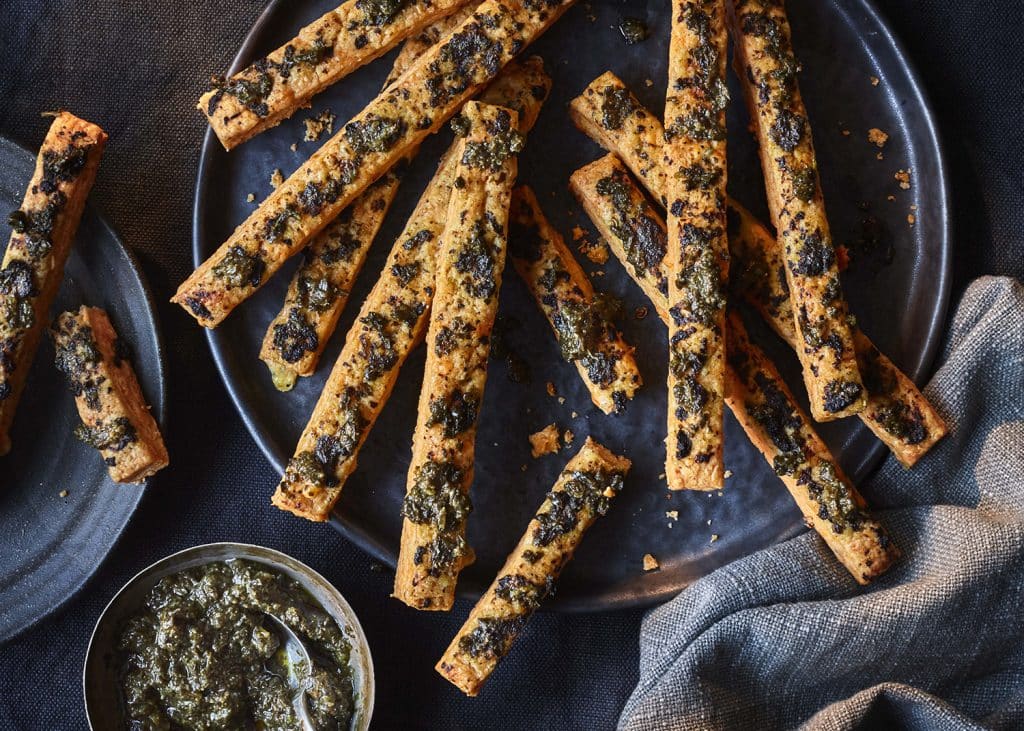
Devils on horseback
The ultimate party bite is something that hits every tastebud at the same time – sweet, savoury, salty and crunchy, all at once. These devils on horseback do just that. For the fruit element, Date Sultan’s premium medjool dates are succulent and juicy. For something a little chewier, the safawi or mabroom, both from Saudi Arabia, have toffee-caramel flavours and a rich dark colour. Alternatively, use dried apricots or figs. For the oozy filling, Blackwood Cheese Company’s Graceburn is perfect – a feta-inspired cheese with a creamier, more buttery texture. Greek wild flower honey sold at Oliveology, Ginger Pig’s smoked streaky bacon – marbled with fat that crisps up perfectly – and Food & Forest’s flavourful walnut kernels from Grenoble finish these morsels off a treat. Serve warm from the oven with champagne, crémant, franciacorta, or a bottle of something else suitably effervescent, ready to pop throughout the night!
Feta & thyme honey devils on horseback
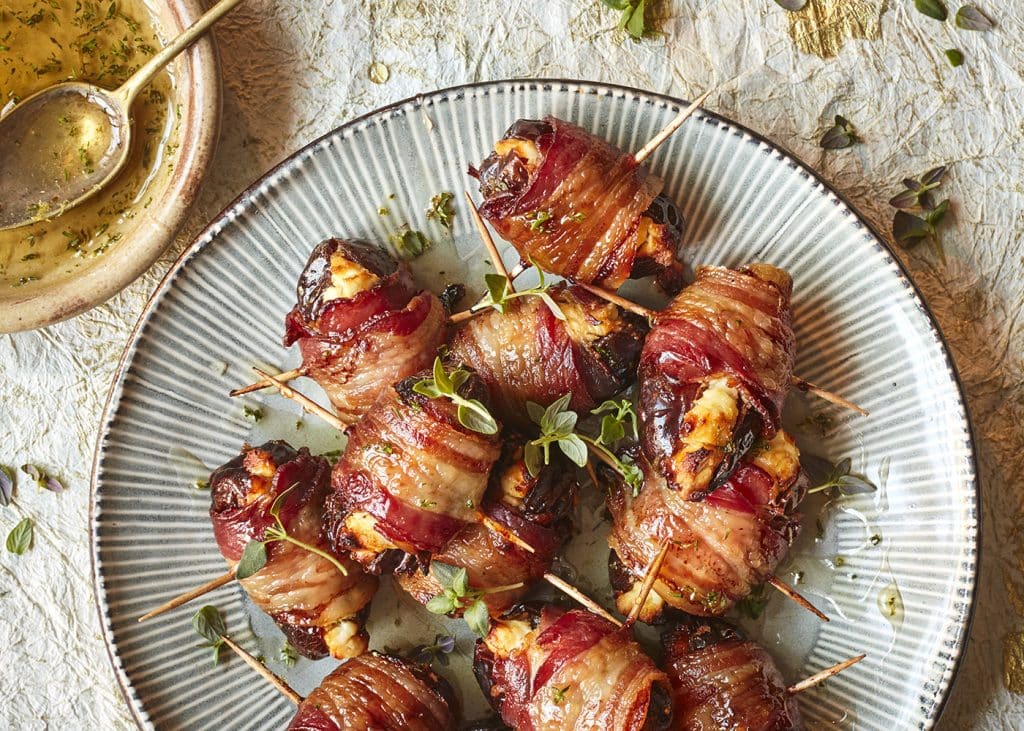
The perfect Christmas cheese board
Ed Smith sets out his vision for the perfect selection of Borough Market cheeses
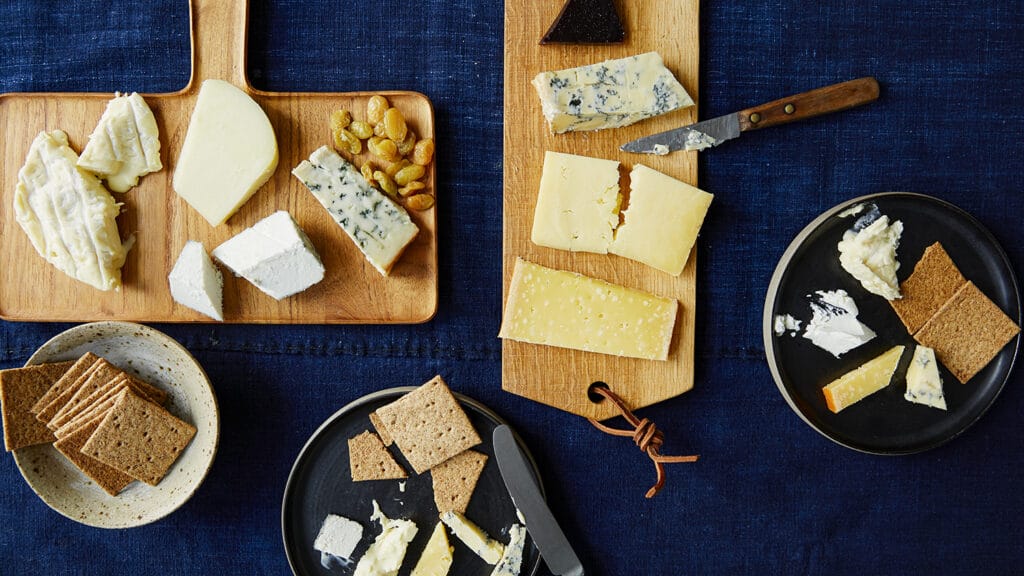

“IF TWO CHEESES MIGHT BE TOO FEW, THEN I THINK THAT ANY MORE THAN SEVEN IS JUST TOO MANY”
Images: Kim Lightbody
When discussing cheeseboard strategy, I normally tend to argue (strongly and perhaps a little patronisingly) that the correct approach, *actually*, is to go big on just one or two things – personally, I’m partial to a quarter of Stichelton and a significant wedge of aged comté.
But let’s be honest, it’s impossible to limit yourself to two types of cheese when you arrive at a good cheesemongers, let alone Borough Market, where there are over 20 different traders from whom you can buy quality, artisan-produced cheese. Still, in pursuit of a balanced board, I do think it’s worth bearing in mind a few guidelines.
If two cheeses might be too few, then I think that any more than seven is just too many. Plumping for five, six or seven cheeses allows you to cover the steady crowd-pleasers, while also exploring a few more leftfield choices. If you lose all self-control, I wonder whether people will really appreciate the effort, or have the chance to appreciate all the cheeses at their peak.
You could of course theme your board by country, though I personally think it’s good to have an open-border policy. At the Market you’ll find world class cheeses from Britain, Ireland, France, Italy, Switzerland, Spain and beyond.
And so, for a varied and balanced selection, I would suggest that the absolute essentials are:
- A characterful hard cheese, such as a farmhouse cheddar, or an Alpine-style cheese akin to a comté or schlossburger
- A mellow blue, such as a stilton or fourme d’Ambert
- A soft blooming rind, such as a brie, camembert or Tunworth
- A sharp goat’s milk cheese – one of the little triangular, cylindrical or cuboid ones.
And then add two or three from the following:
- A ‘stinky’ washed rind cheese, such as an Epoisses or St James
- An ‘unusual’ hard cheese that no one will have had before
- A sharp blue, such as a roquefort or gorgonzola piccante
- A mellow, semi-hard cheese, such as a Morbier, Mayfield or tomme de Savoie
- A ewe’s milk cheese, such as pecorino, manchego or Berkswell
- A ‘novelty’ eye-opener, whether that’s a drunk cheese from L’Ubriaco, Jumi Cheese’s Blue Brain, a brie layered with truffle, or something smoked. Personally, I think it’s best to ignore cheeses flecked with cranberries, even at Christmas, but each to their own.
And don’t forget the condiments. For me the trio comprising an oatcake-style biscuit, a plain cracker and then a wildcard of your choice provides the right balance of intrigue and dependability. The Market isn’t short of fresh grapes and figs, dried fruits, pickles, jellies and pastes such as damson cheese and membrillo. One or two of those will cut through nicely.
Here is my Borough Market cheese board for Christmas 2022:
PITCHFORK CHEDDAR
An unpasteurised farmhouse cheddar from the Somerset-based makers of Gorwydd Caerphilly. Not overly mature or feisty (it’s aged for a touch over 11 months) but it’s characterful, grassy and earthy.
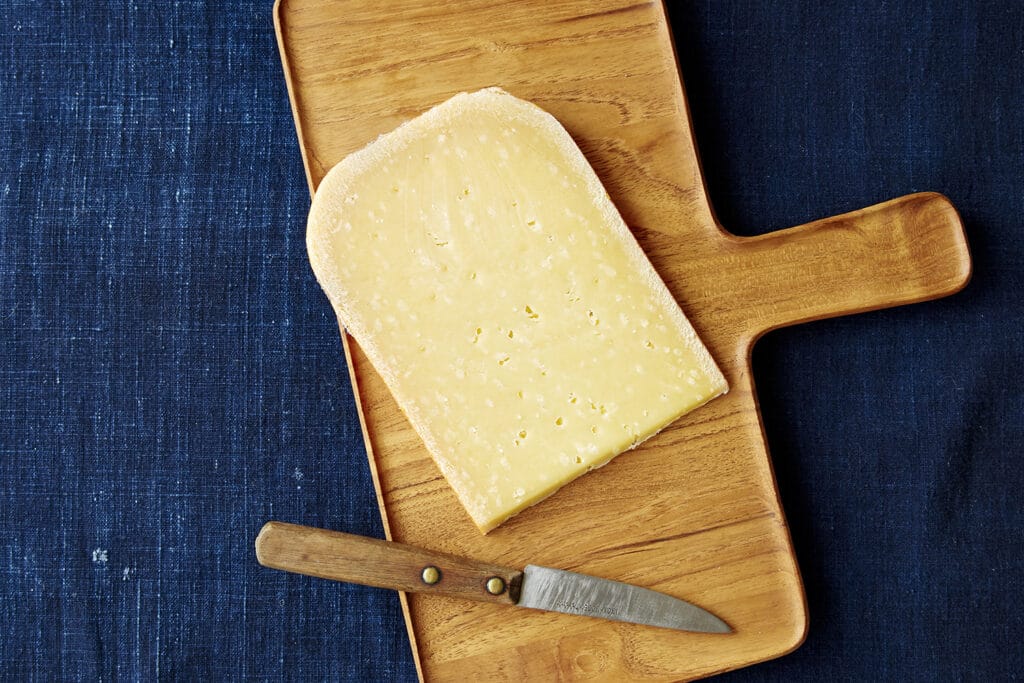
RUYGE WEYDE GOUDA
An 18 month-aged gouda with a really amazing range of flavours (from grassy meadow through to banoffee) and an umami crystal crunch redolent of a punchy parmesan.
BATH BLUE
A mellow, creamy, blue-veined cheese, made at Park Farm from the organic milk of its own herd of cows. Powerful flavour without being gum-receding.
YOUNG PECORINO
Pecorino comes in many guises, and Bianca Mora’s aged variety is exceptional, but I think this young, pale, salty smooth version balances my board really nicely. The flavour of sheep’s milk is really evident.
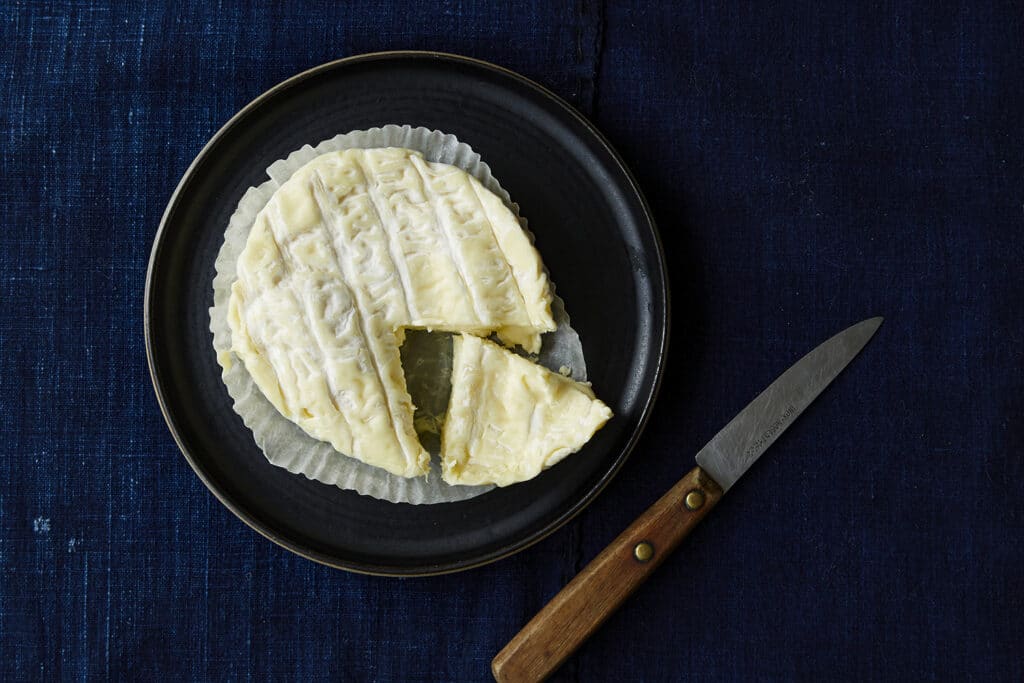
SAINT-FÉLICIEN
This oozy-soft white rind cheese from the Rhône-Alpes region of France is as creamy and luscious as you would expect from something based on double cream. There’s a little tang to it too. A beauty.
DORSTONE
A light and fluffy cylinder of goat’s cheese with a bright white paste, displaying citrus acidity. This will contrast nicely with the likes of Bath Blue and Pitchfork (and indeed the turkey, goose or beef from earlier on).
BASAJO
Here’s my wild card: a sharp soft blue reminiscent of a roquefort, but this time it’s had a swim in passito di Pantelleria, an Italian dessert wine, so there’s a sweet and slightly boozy edge too. You don’t need much per biscuit, and yet it’s remarkably moreish!
Deep and crisp and even
Jane Parkinson plans out her perfect festive wine-drinking day


“IF MOSCATO FOLLOWED BY CHAMPAGNE IS TOO MUCH EFFERVESCENCE, POUR A GLASS OF STILL WHITE INSTEAD”
There are endless reasons to twist a screwcap or pop a cork at this time of year, so the wine options are endless too. Those of us who take pains to drink the right bottle for every occasion can wallow in our obsessions with reckless abandon as we perform the noble task of choosing the wine of the moment. Christmas Day itself is packed full of possibilities, so here’s my guide to the perfect wine styles, from dawn to dusk.
When the adults start opening presents (let’s assume, for the sake of decency, that this is mid to late morning), one delicious, failsafe option is a moscato d’Asti from Piedmont in northern Italy. Its frothy fizz immediately puts a smile on your face (which could be handy if Big Day tensions are already in the air), and its slightly sweet elderflower and pear fruitiness really peps up the palate in a ‘naughty breakfast juice’ kind of way. Perhaps its best attribute is its low alcohol – it rarely exceeds 6.5%, perfect for a wine consumed early in the day. Plus, if there’s any left over, it’s a handy match with trifle.
The next likely wine opportunity would be pre-lunch, perhaps with a plate of smoked salmon. The answer? Champagne, of course. Perhaps try the blanc de blancs style, made with chardonnay only – zesty and light on its feet – or a brut non-vintage style, with its drinkable ratio of fruitiness to toastiness. If moscato followed by champagne is too much effervescence, pour a glass of still white instead. Smoked salmon enjoys many white wines, so this could be the opportunity to try something off-piste but hugely drinkable. The vermentino grape, for example, makes a dry, super-fresh lemon and lime-flavoured wine – a clever and unpredictable option that also makes a great talking point.
And so on to the starters: if you’re having a pâté of some description, crack open a bottle of pinot gris. It’s the same grape as pinot grigio, but when called gris it’s a very different style. Gris is the more serious version, dry or slightly off dry (the latter better with pâté), with a smooth, rounded apple and pear lusciousness. If there is any left over, this grape also makes a great pairing with many cheeses, including brillat-savarin, feta, halloumi or most kinds of goat’s cheese.
For turkey with all the trimmings, red usually works best – even though there is plenty of white meat on the bird, the plate is also adorned with many rich accompaniments. This is where the pinot noir comes in very handy, being a red grape full of sumptuous red fruit flavours as well as a gentle savouriness that respects the earthier flavours of the dish.
We’ll finish, as is only right and proper, with port. Nothing works better with stilton than a glass of vintage port, the sweetness and depth of flavour of which makes it one of the few wines that can match up to the blue cheese’s pungency. For Christmas pudding, mince pies and Christmas cake, a lighter and slightly less expensive tawny port is sheer heaven. Tawnies come in different ages (10, 20, 30 and 40 years old), and the younger the age, the more chilled the drink should be served. Avid port drinkers would declare port to be a course all by itself: the perfect finish to the perfect festive wine drinking day.
